
IRENE MACDONALD
Her bronze medal performance at the Melbourne Olympics in 1956 earned her Canada’s first ever diving medal. It would be 28 years before Canada would win another.
Sa médaille de bronze aux Olympiques de 1956 à Melbourne a été la toute première médaille du Canada en plongeon. Il aura fallu attendre 28 ans avant que le Canada n’en remporte une seconde.
BIOGRAPHY (EN)
Born: November 22, 1931
Hometown: Hamilton, ON
Olympics: Melbourne 1956 / Rome 1960
Highlight: bronze (3m) in 1956
Growing up in an orphanage during the depression and Second World War, Irene began swimming at the Hamilton Aquatics Club before switching over to diving.
From a hesitant start as a shy youngster, she evolved to quite the competitor in winning her first of fifteen national titles in 1951. Irene competed in the era when divers often attended the national championships of other countries. From this international circuit, Irene managed to win six U.S. national titles as well as becoming a two-time Mexican national champion.
At the 1954 Commonwealth Games (then called the British Empire Games) in Vancouver, Irene won a bronze medal. At the next Games in 1958 in Cardiff, Wales, she upgraded to a silver.
Irene qualified for three Olympic Games throughout her career. Unfortunately, she was unable to attend the 1952 games in Finland due to a lack of funding. She did make the Melbourne Games in 1956 and then the Rome Olympics in 1960. Her bronze medal performance at the Melbourne Olympics in 1956 earned her Canada’s first ever diving medal. It would be 28 years before Canada would win another.
After her diving career ended, Irene gave back to the community as a coach, as a director of the national diving association, as well as the executive director of B.C. provincial diving association. She reached the most people as a colour commentator for the diving events with CBC at the Olympics from 1976 in Montreal until the 1988 Seoul Games.
Irene was inducted into the Canadian Sports Hall of Fame in 1981.
BIOGRAPHIE (FR)
Date de naissance: 22 novembre 1931
Ville natale: Hamilton, ON
Olympique: Melbourne 1956 / Rome 1960
Fait saillant: bronze (3m) en 1956
Élevée dans un orphelinat pendant la Grande Dépression et la Seconde Guerre mondiale, Irene nageait avec le Hamilton Aquatics Club avant de passer au plongeon.
De la jeune fille timide à ses débuts, elle a montré l’esprit de compétition qui l’animait lorsqu’elle a remporté le premier de ses quinze titres nationaux. Irene a rivalisé en plongeon au cours d’une période où il était possible de participer aux championnats nationaux d’autres pays. Sur ce circuit international, Irene a remporté le championnat des États-Unis à six reprises, en plus du championnat du Mexique à deux reprises.
Aux Jeux du Commonwealth de 1954 (alors appelés les Jeux de l’Empire britannique) à Vancouver, Irene a remporté la médaille de bronze. À la prochaine édition des Jeux à Cardiff, au pays de Galles en 1958, elle a surclassé sa médaille en remportant l’argent.
Irene s’est qualifiée à trois Jeux olympiques au cours de sa carrière. Malheureusement, elle n’a pu participer aux Jeux de 1952 en Finlande à cause d’un manque de financement. Elle s’est toutefois rendue aux Jeux de Melbourne en 1956 et ensuite à Rome en 1960. Sa médaille de bronze aux Olympiques de 1956 à Melbourne a été la toute première médaille du Canada dans le sport du plongeon. Il aura fallu attendre 28 ans avant que le Canada n’en remporte une seconde.
À la fin de sa carrière de plongeon, Irene a redonné à sa communauté dans ses rôles d’entraîneure, de membre du conseil de l’association nationale de plongeon et de directrice générale de l’association provinciale de plongeon de la Colombie-Britannique. Elle a rejoint le public dans son rôle d’analyste pour la CBC lors des épreuves de plongeon aux Olympiques de Montréal en 1976 jusqu’aux Olympiques de 1988 à Séoul.
Irene a été intronisée au Panthéon des sports canadiens en 1981.
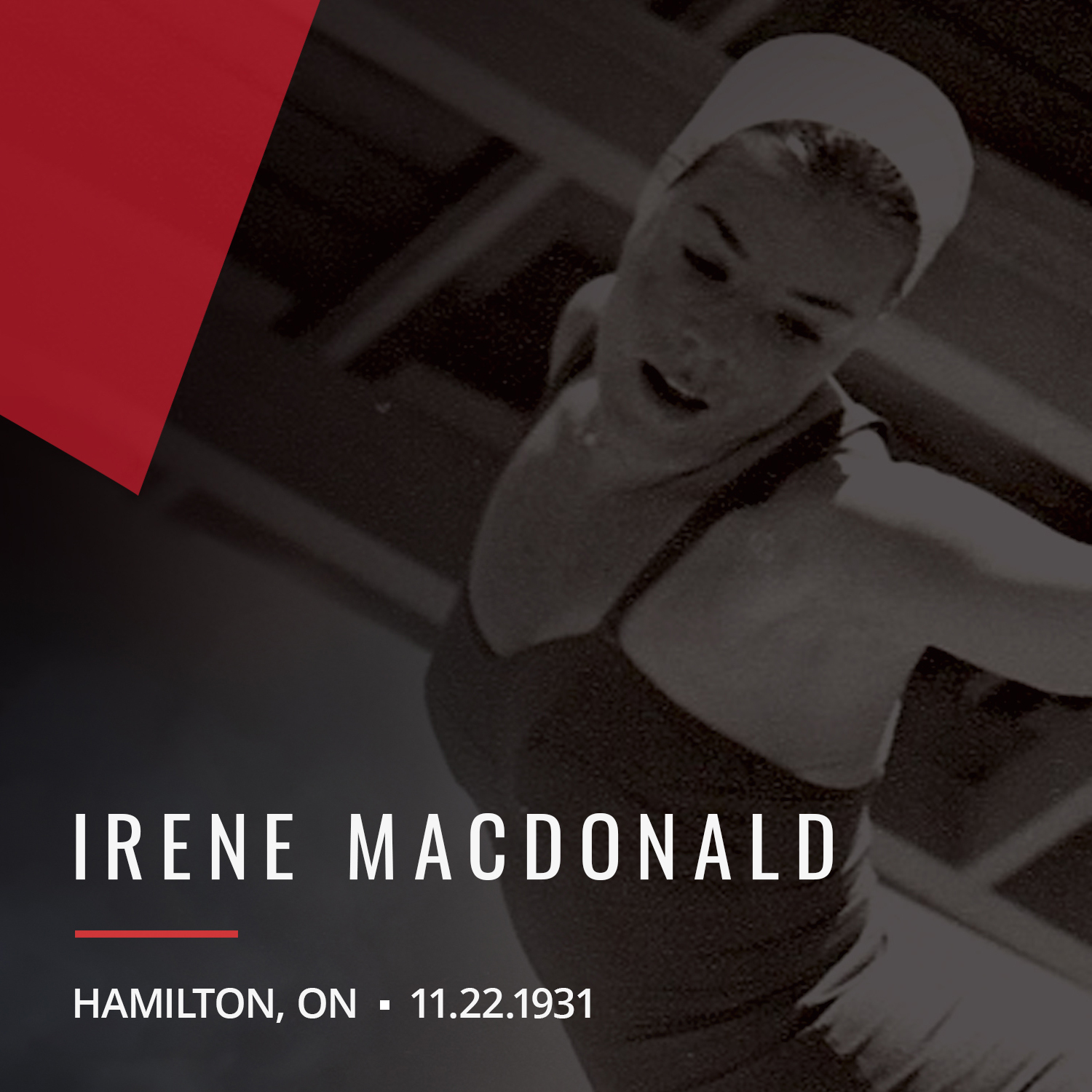
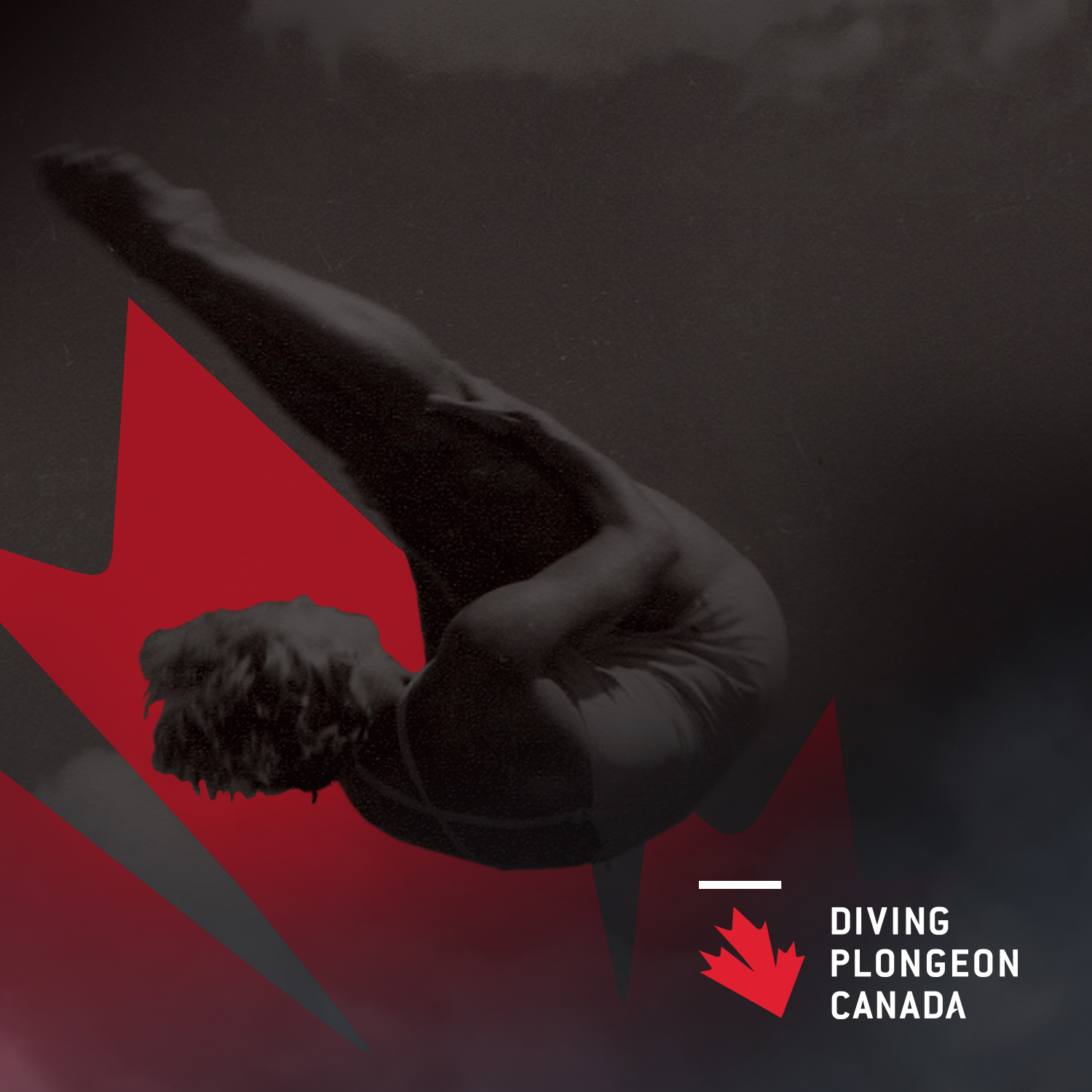
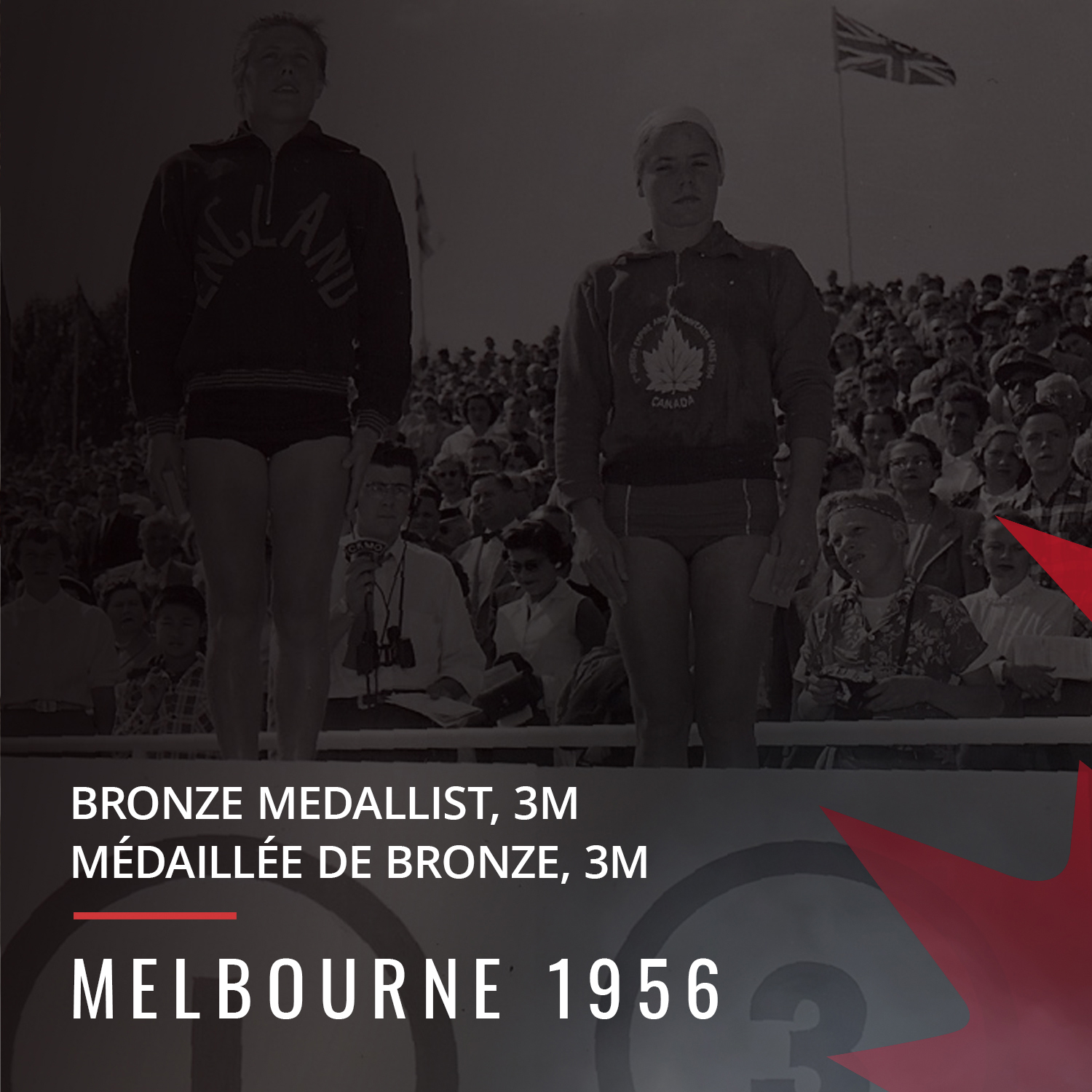
SYLVIE BERNIER
Sylvie made history at the 1984 Olympic Games by winning gold in the women’s 3m, and to this day it remains Canada’s only Olympic title in diving.
Sylvie a marqué l’histoire aux Jeux olympiques de 1984 en remportant l’or à l’épreuve du 3m féminin, encore aujourd’hui la seule médaille d’or olympique du Canada en plongeon.
BIOGRAPHY (EN)
Born: January 31st, 1964
Hometown: Sainte-Foy, QC
Olympics: Los Angeles 1984
Highlight: gold (3m) in 1984
Sylvie first found her way to the pool when her doctor recommended regular exercise to help with her asthma. She started in swimming but was soon drawn to the divers as she watched them impressively jump, flip and twist off the boards. At age 11, she began training at the Club de plongeon Rouge et Or at l’Université de Laval in Québec City.
At the 1976 Olympics in Montreal, a 12-year old Sylvie watched eagerly from the stands as Jennifer Chandler (USA) won gold in the women’s 3m competition, and a young Greg Louganis (USA) nearly prevented the legendary Klaus Dibiasi (ITA) from winning his record setting third straight Olympic gold on the 10m platform. Seeing legends of her sport this closely significantly impacted Sylvie, and this experience remained with her throughout her diving career.
A few years later, Sylvie was competing on the national level, and was able to capture her first national title at age 16. From that result shedared to believe she could achieve the same results as those Olympians she had seen at the 1976 Games.
In order to chase her dreams, Sylvie moved to Montreal to train with coach Donald Dion at Club Aquatique de Montréal (CAMO). At this point, the Chinese team had just started competing internationally and their dynamic new style was influencing Sylvie.
On the heels of her first major games podium finish at the 1982 Commonwealth Games, Sylvie broke through on the international scene in a big way. At the 1983 German Grand Prix in Rostock, long-regarded as the marquee stop along the diving grand prix dominated by Russians and Germans, Sylvie ended a 27-year North American drought by winning gold on 3m. This win showed everyone that Sylvie was a true contender heading into the 1984 Olympic Games in Los Angeles.
As we know, Sylvie made history at those 1984 Olympic Games by winning gold in the women’s 3m, and to this day it remains Canada’s only Olympic title in diving.
Following her retirement from competitive sport in 1984, Bernier became involved in television broadcasting, commentating at Seoul 1988 and Barcelona 1992. She was Chef de Mission for the Canadian Olympic Team at Beijing 2008 and assistant Chef de Mission at Turin 2006 and London 2012. (source: COC)
In 1985, Sylvie she was made a Knight of the National Order of Québec, a Member of the Order of Canada, and was inducted into the Canadian Olympic Hall of Fame.
BIOGRAPHIE (FR)
Date de naissance: 31 janvier 1964
Ville natale: Sainte-Foy, QC
Olympique: Los Angeles 1984
Fait saillant: or (3m) en 1984
Sur l’avis du médecin, Sylvie s’est retrouvée à la piscine pour y faire un peu d’activité physique régulière pour aider à maîtriser son asthme. Elle a commencé par s’adonner à la natation mais elle était fascinée par les plongeurs, impressionnée par les sauts, les périlleux et les vrilles qu’ils effectuaient du tremplin. À l’âge de 11 ans, elle débutait l’entraînement au Club de plongeon Rouge et Or de l’Université Laval à Québec.
Aux Jeux Olympiques de 1976 à Montréal, la jeune Sylvie, âgée de 12 ans, assistait avidement des gradins lorsque l’Américaine Jennifer Chandler a remporté la médaille d’or à l’épreuve du 3m féminin et que son compatriote, le jeune Greg Louganis a failli empêcher le légendaire Italien Klaus Dibiasi d’établir une marque record d’une troisième médaille d’or olympique consécutive à la plateforme de 10m. De voir les légendes de son sport en action d’aussi près a eu un impact significatif sur Sylvie, une expérience qui l’a marquée tout au long de sa carrière de plongeon.
Quelques années plus tard, Sylvie rivalisait au niveau national et a remporté son premier titre national à 16 ans. Ce résultat lui a permis de croire qu’elle aussi pouvait rêver de résultats olympiques semblables à ceux qu’elle avait vus aux Jeux de 1976.
Pour concrétiser son rêve, Sylvie est déménagée à Montréal pour s’entraîner avec Donald Dion au Club Aquatique de Montréal (CAMO). À ce moment-là, l’équipe chinoise venait tout juste de faire son entrée sur la scène internationale et Sylvie était influencée par leur nouveau style dynamique.
À la suite de son premier podium de Grands Jeux aux Jeux du Commonwealth de 1982, Sylvie a signalé sa présence sur la scène internationale. Au Grand Prix d’Allemagne de Rostock, considéré l’étape la plus prestigieuse du circuit du Grand Prix de plongeon dominée par les plongeurs russes et allemands, Sylvie a mis fin une pénurie de médailles pour l’Amérique du Nord vieille de 27 ans en remportant l’or au 3m. Cette victoire a annoncé au monde entier que Sylvie était une prétendante sérieuse à la médaille d’or aux Jeux Olympiques de 1984 à Los Angeles.
Comme nous le savons, Sylvie a marqué l’histoire à ces Jeux olympiques de 1984 en remportant l’or à l’épreuve du 3m féminin, encore aujourd’hui la seule médaille d’or olympique du Canada en plongeon.
Après sa retraite de la compétition sportive en 1984, Bernier a fait ses débuts en télévision, agissant comme commentatrice aux Jeux de Séoul 1988 puis à Barcelone 1992. Elle a été chef de mission pour l’équipe canadienne olympique à Beijing 2008 et chef de mission adjointe à Turin 2006, puis à Londres 2012. (source: COC)
En 1985, Sylvie a été nommée chevalière de l’Ordre national du Québec, membre de l’Ordre du Canada et a été intronisée au Temple de la renommée olympique du Canada.
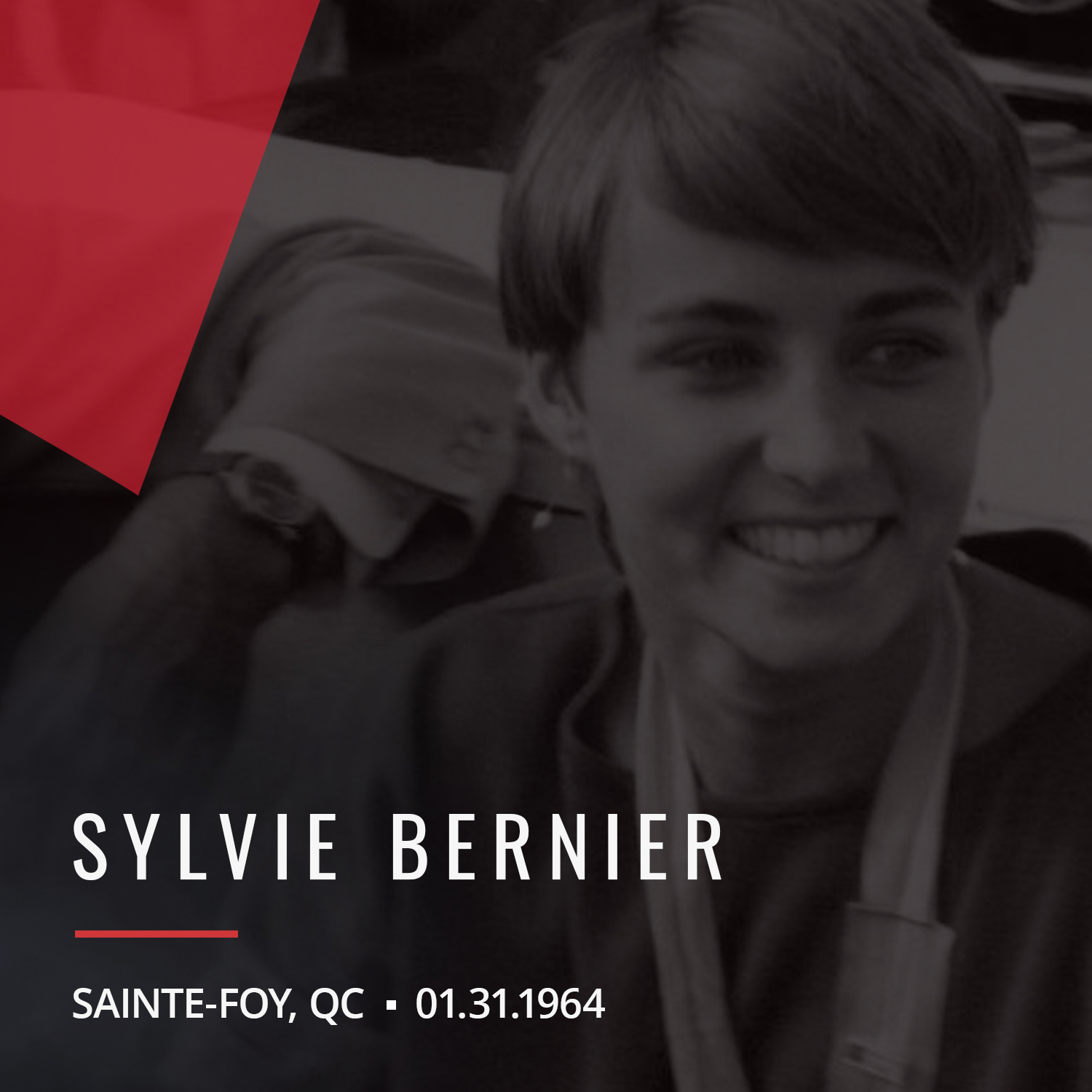
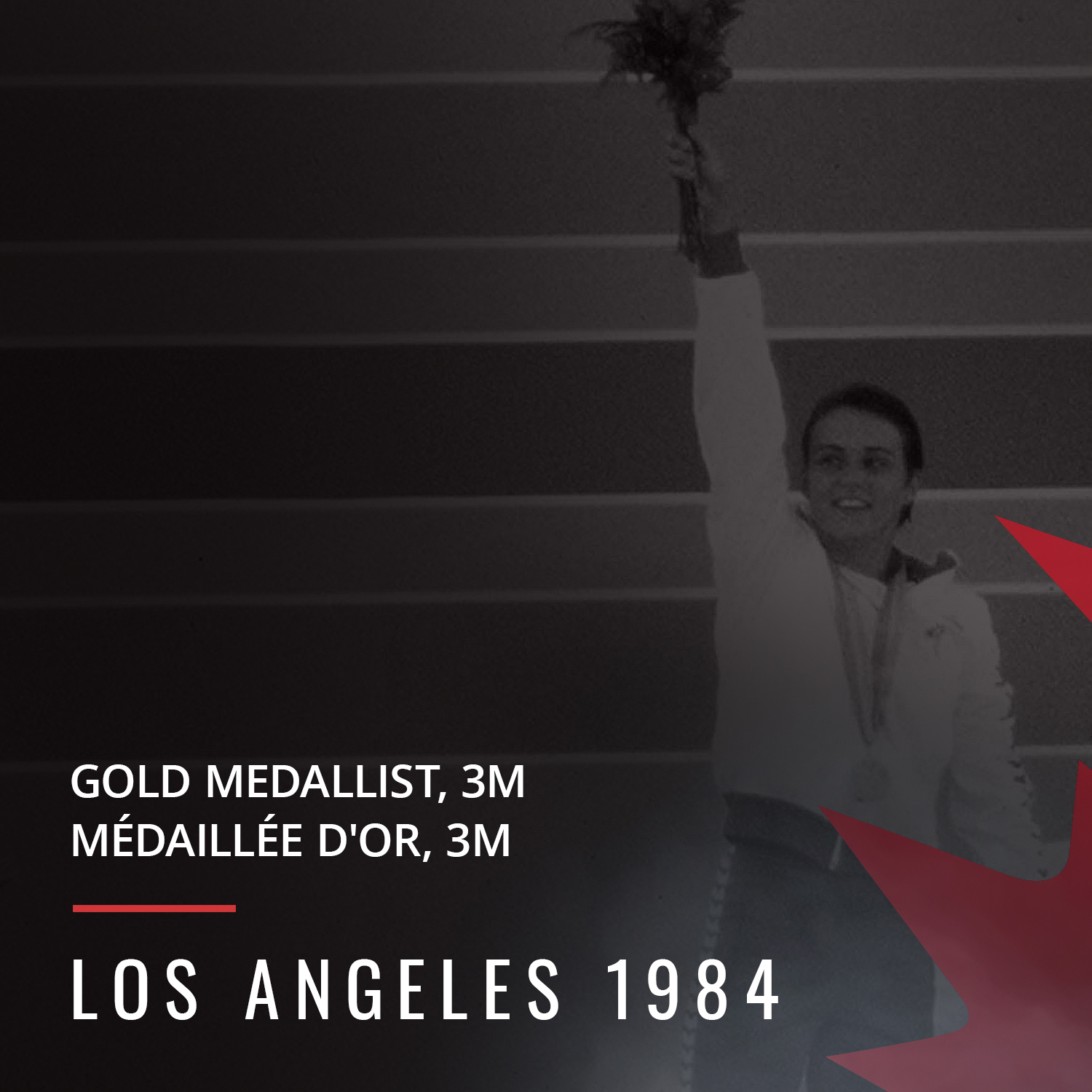
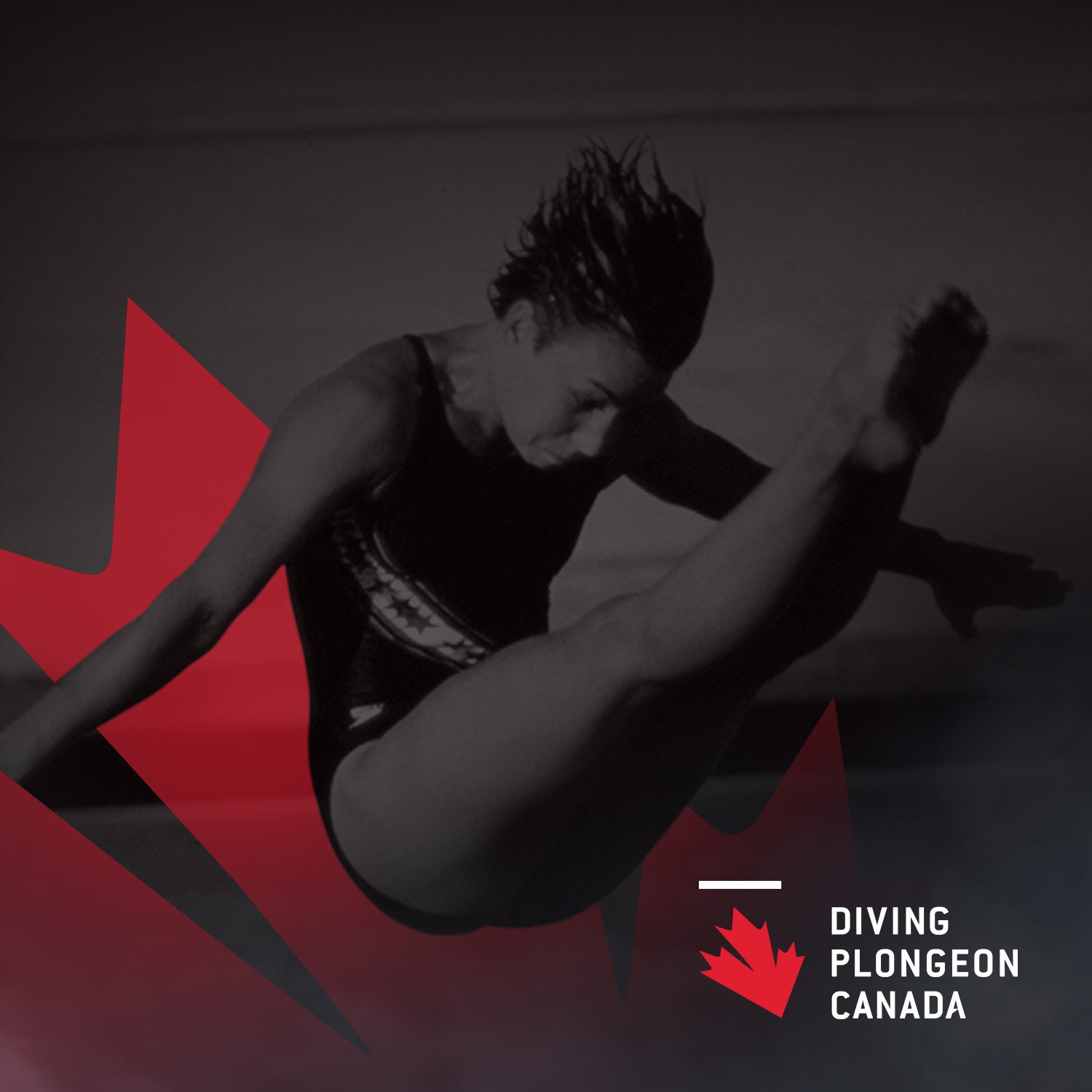
ANNIE PELLETIER
In Atlanta in 1996, Annie won Canada’s third Olympic diving medal ever with her exciting bronze medal on the 3m springboard.
En 1996 à Atlanta, Annie a remporté la troisième médaille olympique du Canada en plongeon grâce à sa sensationnelle médaille de bronze au tremplin de 3m.
BIOGRAPHY (EN)
Born: December 22, 1973
Hometown: Montreal, QC
Olympics: Atlanta 1996
Highlight: bronze (3m) in 1996
By modern day standards, Annie was “ancient” by the time she started diving at the age of thirteen. In fact, it was initially against her will that Annie’s parents pulled her out of gymnastics and brought her to the pool to give diving a try. Her acrobatic skills more than made up for the “late” start, and Annie was noticed immediately. Her bounding quickness, ballerina toe point and elegant diving positions drew everyone’s attention as she accelerated to the top of the field.
Her big breakthrough in the sport came when she won a silver medal at the Canada Games in 1989 on 3m. Two weeks before the event, she was recovering from a nasty scrape with the board that needed 40 stitches. But to deliver a career defining performance amidst the adversity made Annie believe that she could become a champion. Now she was focused on becoming not only the best in Canada, but soon the best in the world.
All divers have significant figures in their careers. For Annie, that person was Donald Dion, the head coach of the CAMO diving club at the time. Donald started her in diving and then came back to coach her to the Olympic podium seven years later. He instilled confidence, consistency, happiness and pride. She was also inspired by diving legends Greg Louganis (USA), Sylvie Bernier (CAN), and Dmitri Sautin (RUS).
Annie went on to participate and win medals for Canada at all major games in which diving participates. She impressively was a double gold medallist at both the 1994 Commonwealth Games and the 1995 Pan American Games.
Finally, in Atlanta in 1996, Annie won Canada’s third Olympic diving medal ever with her exciting bronze medal on the 3m springboard.
Annie was inducted into the Canadian Olympic Hall of Fame in 2003.
BIOGRAPHIE (FR)
Date de naissance: 22 décembre 1973
Ville natale: Montréal, QC
Olympique: Atlanta 1996
Fait saillant: bronze (3m) en 1996
Annie Pelletier, 13 ans, n’était certes pas la plus jeune des recrues lorsqu’on l’a été initiée au plongeon. En effet, c’était initialement contre son gré que ses parents l’ont sortie de la palestre pour l’amener à la piscine pour tenter d’apprivoiser le tremplin. Toutefois, ses talents acrobatiques ont plus que compensé pour ses débuts tardifs dans le sport et Annie a immédiatement été remarquée. Ses sauts rapides, orteils pointés de ballerine et positions de plongeon élégantes n’ont pas manqué d’attirer l’attention lors de sa course vers le sommet du sport.
Sa percée s’est produite au tremplin de 3m aux Jeux du Canada de 1989 lorsqu’elle a remporté la médaille d’argent. Deux semaines avant l’événement, elle s’était gravement égratignée avec le tremplin, nécessitant 40 points de suture. Face à l’adversité, Annie a su livrer une performance incroyable, ce qui lui a permis de croire en ses capacités. Ainsi, elle a investi toute son énergie pour se tailler une place parmi les meilleures au Canada, et peu après, parmi les meilleures au monde.
Tous les plongeurs sont marqués par des personnes qui ont un impact important dans leur carrière. Pour Annie, cette personne était Donald Dion, alors l’entraîneur-chef du club CAMO. Donald l’a initiée au plongeon et est revenu à ses côtés sept ans plus tard pour l’accompagner vers le podium olympique. Donald lui inspirait confiance, constance, joie et fierté. Elle était aussi inspirée par ses héros, les légendes du plongeon Greg Louganis (États-Unis), Sylvie Bernier (Canada) et Dmitri Sautin (Russie).
Annie a représenté le Canada à tous les Grands Jeux où figurent le plongeon et a accédé au podium à chacun d’eux. Parmi ses victoires impressionnantes, notons ses médailles d’or aux Jeux du Commonwealth de 1994 et aux Jeux panaméricains de 1995.
Finalement, en 1996 à Atlanta, Annie a remporté la troisième médaille olympique du Canada en plongeon grâce à sa sensationnelle médaille de bronze au tremplin de 3m.
Annie a été intronisée au Temple de la renommée olympique du Canada en 2003.
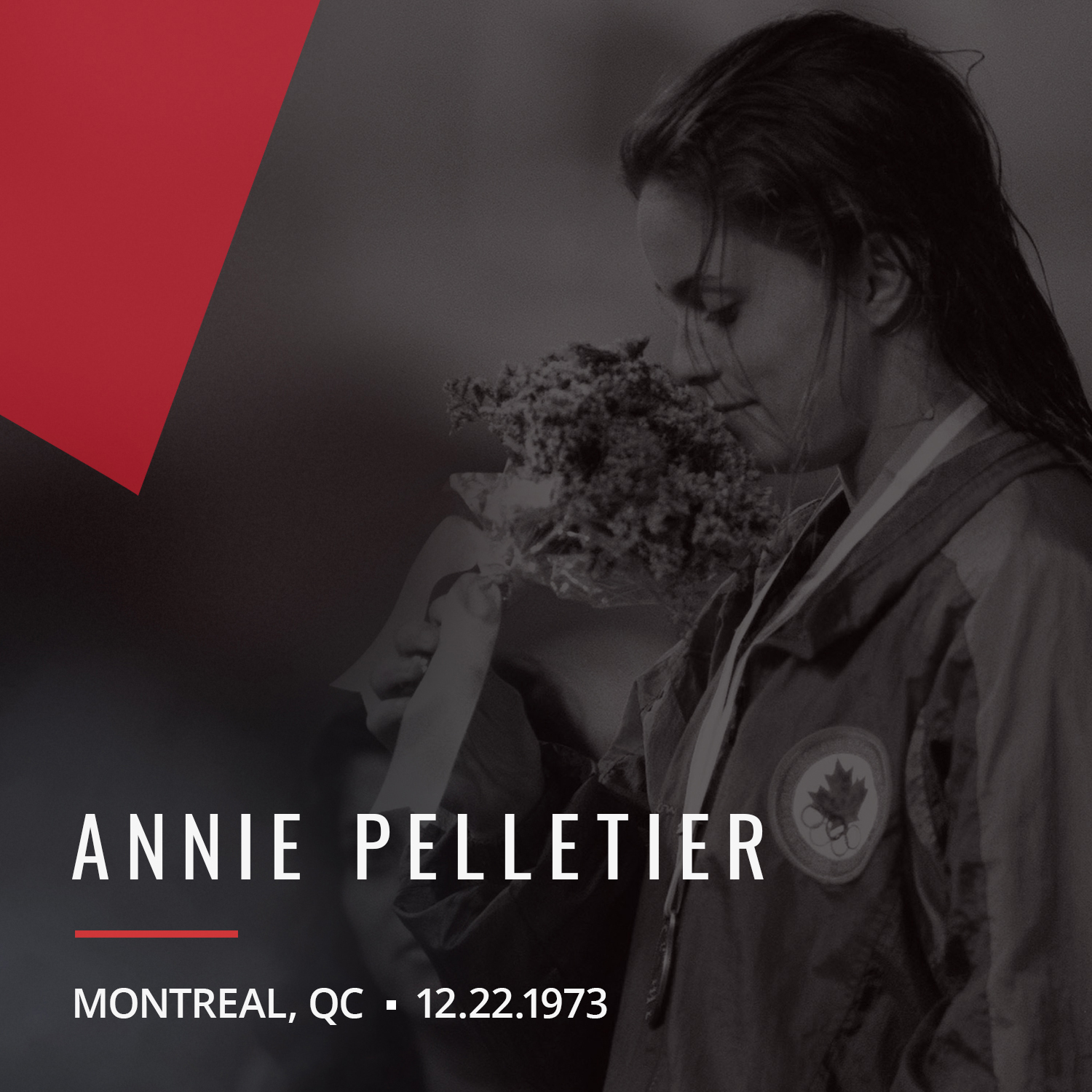
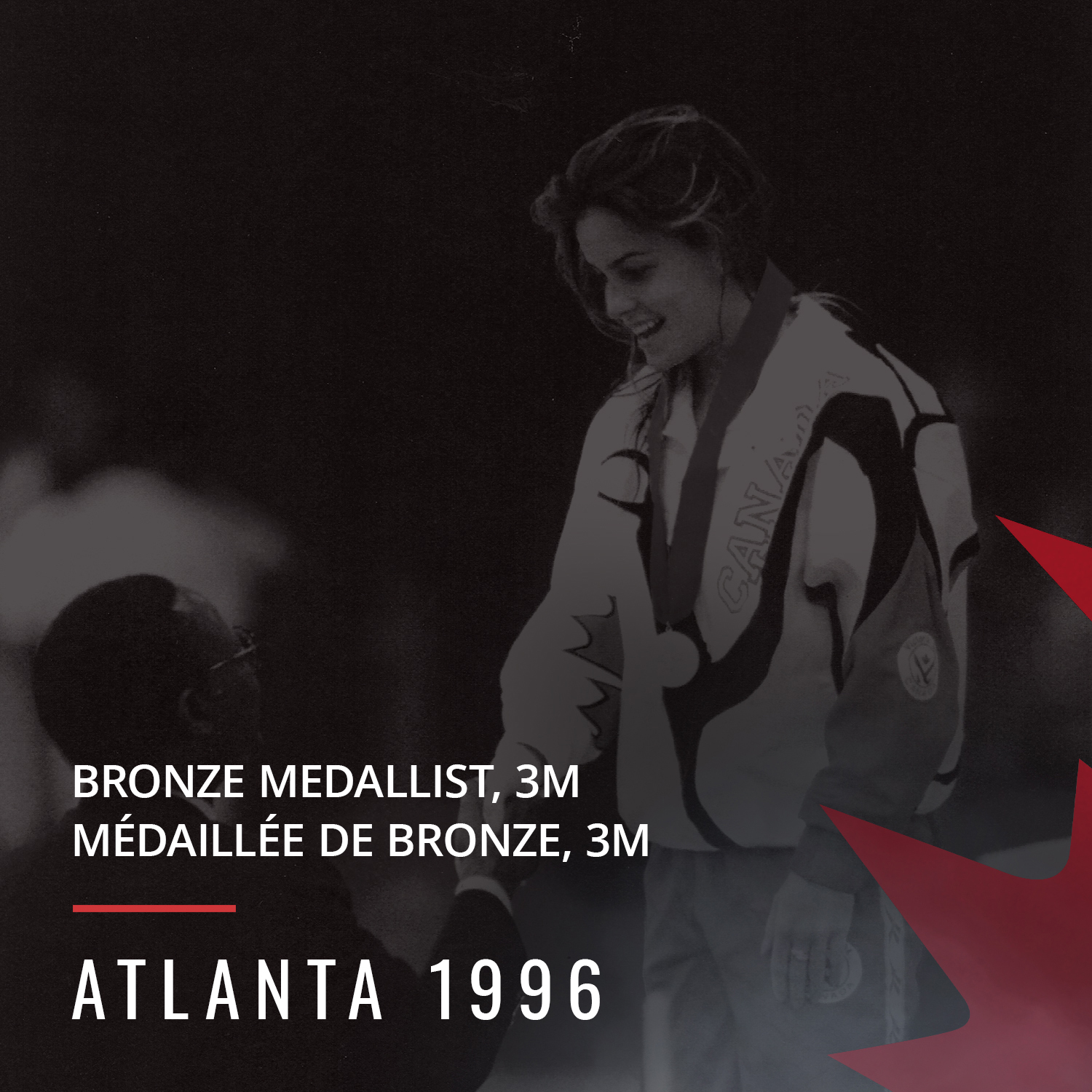
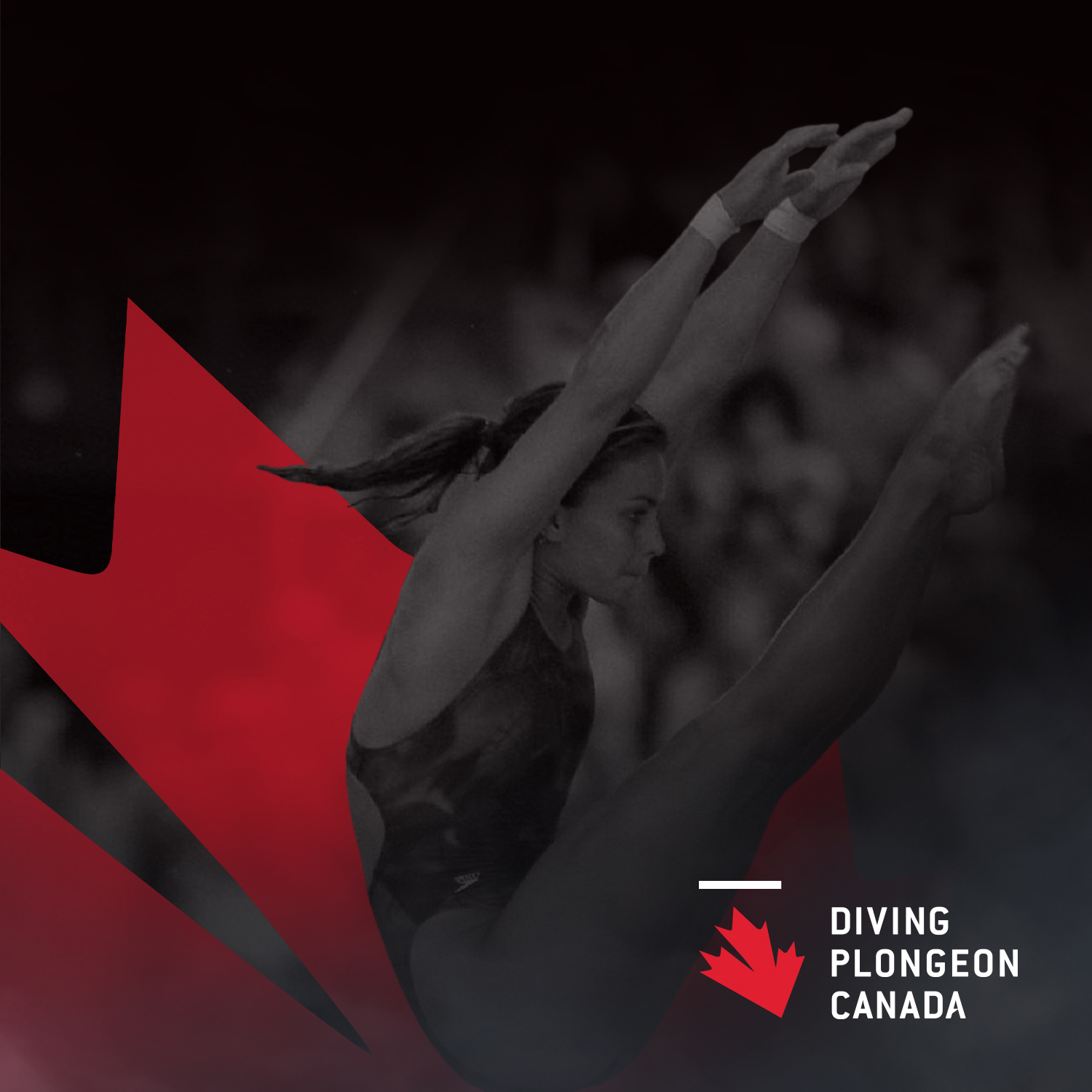
ANNE MONTMINY
In Sydney, Anne steps onto the podium twice, winning an individual bronze in the 10m event as well as a silver with Émilie Heymans in 10m synchro the first year that synchronized diving was held at the Olympics. She becomes the first Canadian diver to bring home two medals from a single game.
À Sydney, soit ses troisième Jeux olympiques, elle a gravi le podium à deux reprises : remportant une médaille de bronze individuelle à l’épreuve du 10 mètres et une médaille d’argent avec Émilie Heymans au 10m synchro à la première tenue de l’événement aux olympiques. Elle devient ainsi la première plongeuse canadienne à ramener deux médailles des mêmes Jeux olympiques.
BIOGRAPHY (EN)
Born: January 25, 1975
Hometown: Montreal, QC
Olympics: Barcelona 1992, Atlanta 1996, Sydney 2000
Highlight: bronze (10m), silver (10m synchro) in 2000
Anne’s family was a major influence on the start of her diving career, as her first lessons came as a gift from her father on her 6th birthday. Soon after, the entire family moved to Pointe Claire where Anne and her siblings all took up the sport, growing up together at the pool. Anne credits her coaches, the environment, and her teammates at the Pointe-Claire Diving Club for making the pool a fun place to spend the majority of her early years.
Through this support, Anne would go on to make many junior international teams, but the 1986 World Junior Championships in Woodlands, Texas were especially memorable. Competing alongside the best divers her age in the world left her believing that she belonged in this space and would work hard to become one of the best in the world herself.
In 1992, she qualified for her first of three Olympic Games, eventually representing Canada in Barcelona (1992), Atlanta (1996), and Sydney (2000).
In 1994, in front of a Canadian crowd, Anne would win the women’s 10m platform event at the Commonwealth Games in Victoria. A year later she won the gold in the same event at the 1995 Pan American Games in Mar del Plata, Argentina.
At her third Olympics, Anne’s hard work finally paid off after finally earning the right to step onto an Olympic podium. In Sydney she was able to do this twice, winning an individual bronze in the 10m event as well as a silver with Émilie Heymans in 10m synchro the first year that synchronized diving was held at the Olympics.
Impressively, Anne completed her law degree the year before the 2000 Olympics and would go on to practice law after her retirement from diving. Anne also worked as a commentator for CBC during the 2008 Olympics, sharing her expertise and experience for the Canadian audience.
She was inducted into the Canadian Olympic Hall of Fame in 2005.
BIOGRAPHIE (FR)
Date de naissance: 25 janvier 1975
Ville natale: Montréal, QC
Olympique: Barcelone 1992, Atlanta 1996, Sydney 2000
Fait saillant: bronze (10m), argent (10m synchro) en 2000
La famille d’Anne a fortement influencé son début de carrière en plongeon : pour son 6e anniversaire, son papa lui avait offert ses premières leçons. Peu après, la famille tout entière est déménagée à Pointe -Claire où Anne, son frère et sa sœur s’adonnaient au plongeon, grandissant ensemble autour de la piscine. Anne attribue le plaisir qu’elle a eu à la piscine au cours de ses années formatrices à ses entraîneurs, à l’environnement positif et à ses coéquipiers du Club de plongeon Pointe-Claire.
Grâce à ce soutien, Anne s’est qualifiée pour plusieurs équipes internationales junior. Pour elle, ce sont les Championnats du monde junior de 1986 à Woodlands, au Texas qui ont été les plus mémorables. De rivaliser aux côtés des meilleures plongeuses de son âge lui a permis de croire qu’elle avait sa place parmi elles et lui a donné la motivation de travailler encore plus fort pour devenir l’une des meilleures plongeuses du monde.
En 1992, elle s’est qualifiée à ses premiers Jeux olympiques. Elle a éventuellement représenté le Canada aux Olympiques à trois reprises : Barcelone (1992), Atlanta (1996) et Sydney (2000).
En 1994, devant ses partisans, Anne a remporté la médaille d’or à l’épreuve de la plateforme de 10m féminine aux Jeux du Commonwealth à Victoria. Un an plus tard, elle a récidivé en remportant l’or à la même épreuve aux Jeux panaméricains de 1995 à Mar del Plata, en Argentine.
À ses troisièmes Jeux olympiques, tout son travail a finalement porté fruit lorsqu’elle a accédé à son premier podium olympique. À Sydney, elle a pu le gravir à deux reprises : remportant une médaille de bronze individuelle à l’épreuve du 10 mètres et une médaille d’argent avec Émilie Heymans au 10m synchro à la première tenue de l’événement aux Olympiques.
De plus, Anne a réussi l’exploit impressionnant de compléter son diplôme en droit l’année avant les Jeux de 2000 et a par la suite pratiqué le droit après sa retraite du plongeon. Elle a aussi été commentatrice pour CBC aux Olympiques de 2008, partageant son expertise et son expérience avec le public canadien.
Elle a été intronisée au Temple de la renommée olympique du Canada en 2005.
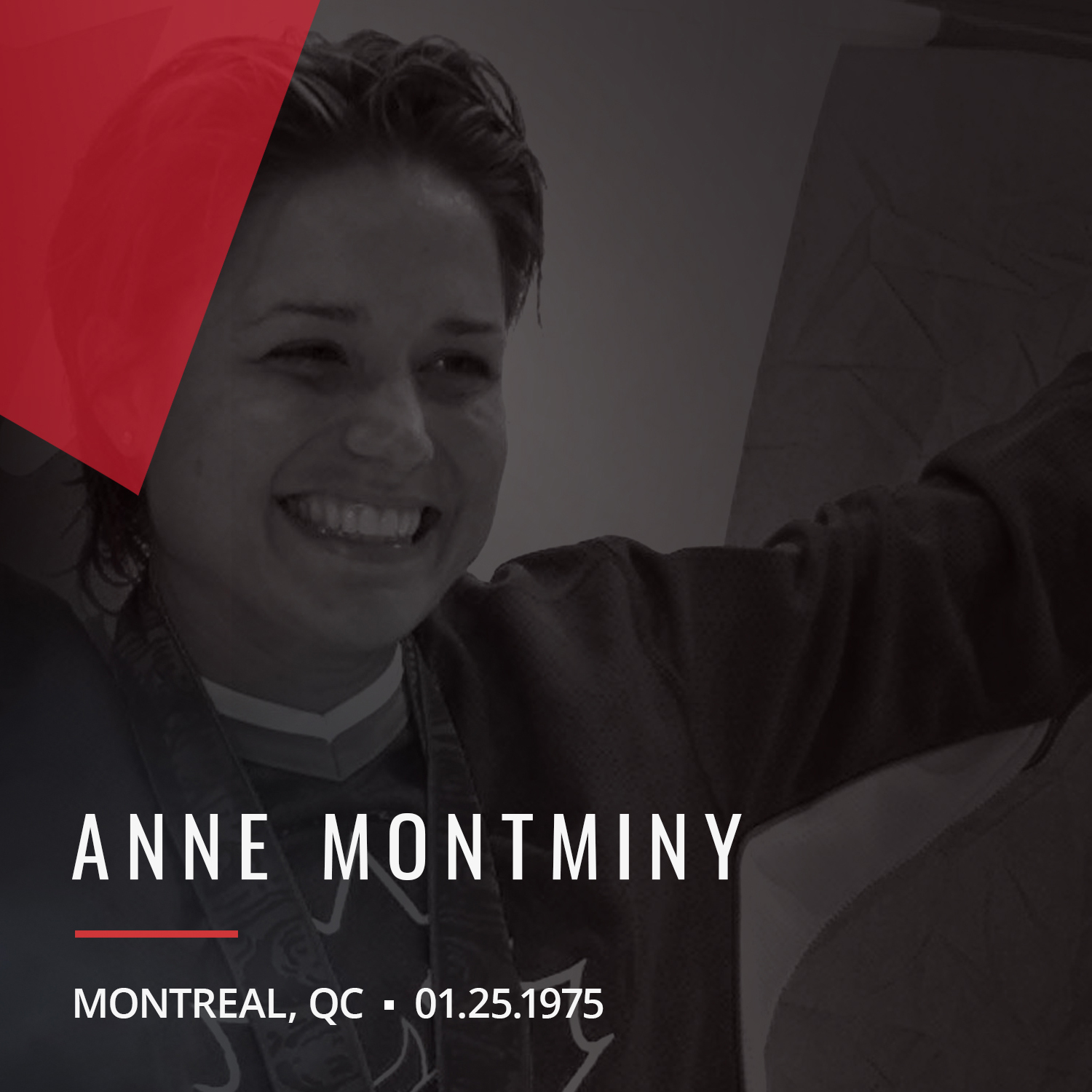
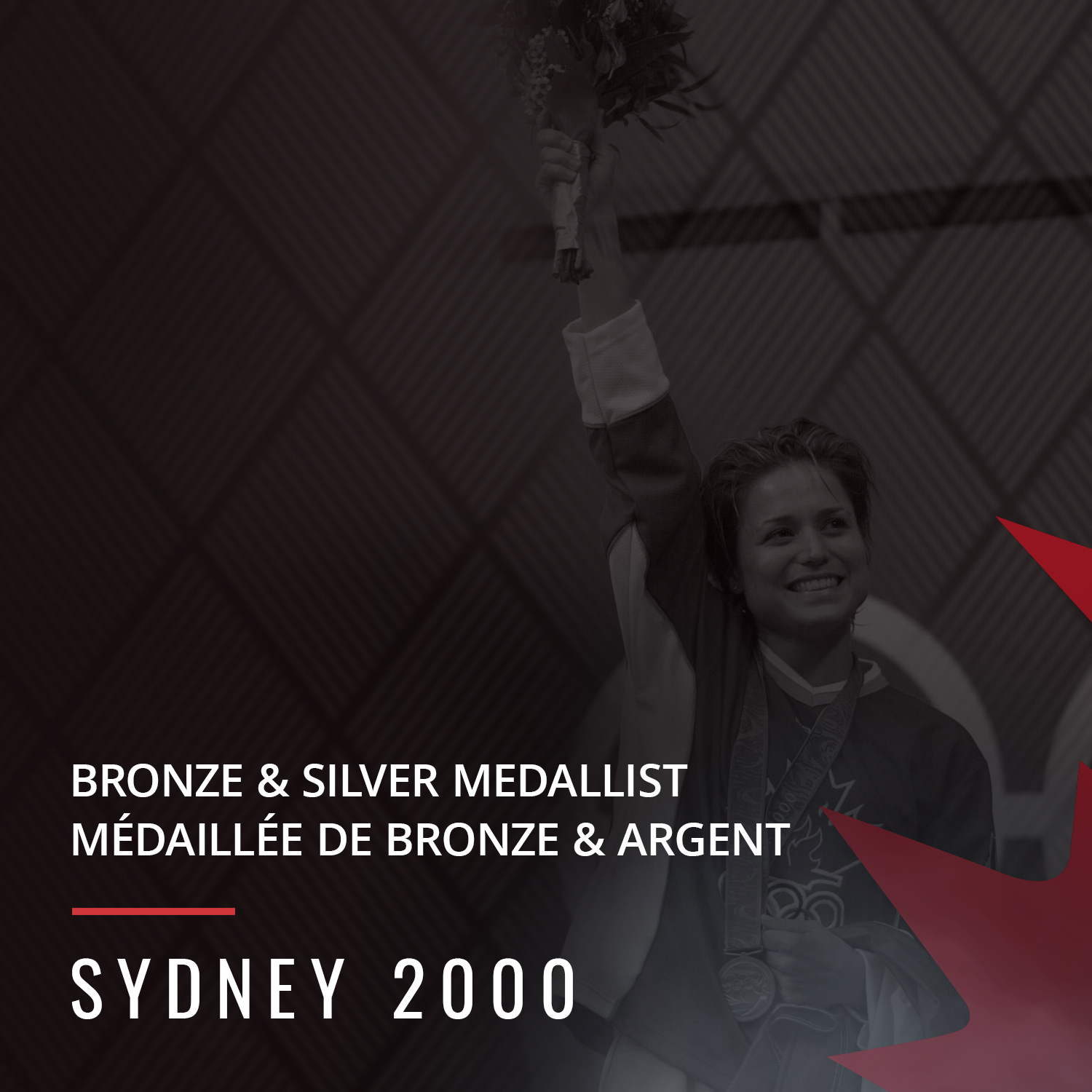
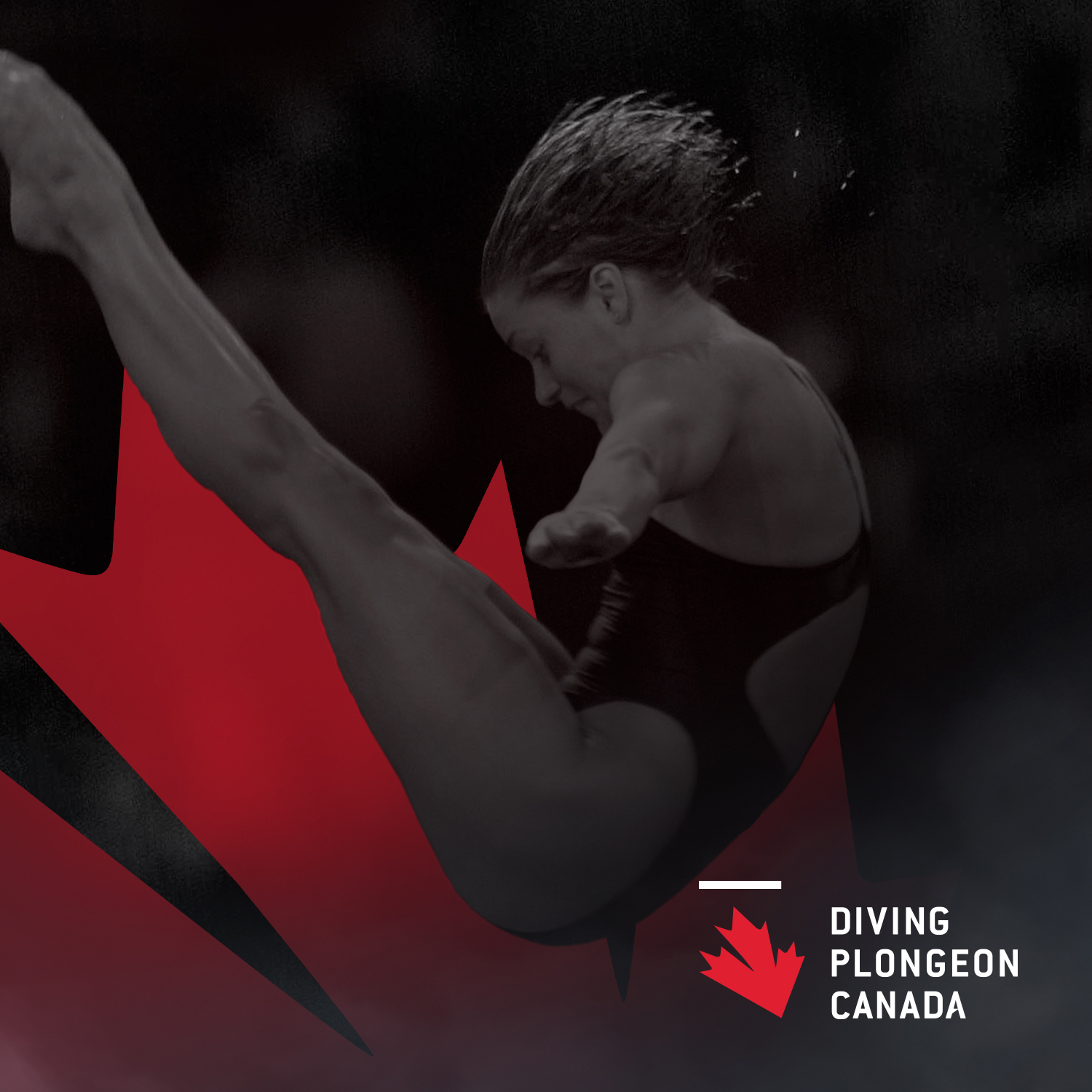
BLYTHE HARTLEY
A two-time world champion on 1m, Blythe competed at the Sydney (2000), Athens (2004) and Beijing (2008) Olympic Games. She continuously improved on her individual finishes from 10th to 5th to 4th in the 3m individual event while winning a bronze medal with Emilie Heymans in the 10m synchro event in 2004.
Double championne du monde au 1m, Blythe a participé aux Jeux olympiques de Sydney (2000), d’Athènes (2004) et de Pékin (2008). En plus de constamment améliorer ses performances individuelles aux JO, elle a remporté une médaille de bronze avec Émilie Heymans en 2004, à l’épreuve du 10m synchro.
BIOGRAPHY (EN)
Born: May 2, 1982
Hometown: North Vancouver, BC
Olympics: Sydney 2000, Athens 2004, Beijing 2008
Highlight: bronze (10m synchro) in 2004
Blythe started her athletic career by competing in both gymnastics and swimming. It didn’t take much convincing from her mother (a former diver herself) for Blythe to combine these two sports and switch her focus to diving. Blythe made quick strides at the Vancouver Aquatic Centre as a powerful springboard and platform diver, and broke onto the senior national scene while still a junior. She placed second on 10m at the senior nationals when she was 16, which qualified her for her first Commonwealth Games in 1998. Her unexpected result moved her to tears. The reaction revealed Blythe’s trademark humility in that she never took winning for granted and approached each competition like the underdog.
Blythe was fortunate to be surrounded with an excellent group of role models and teammates throughout her career. Through their influence, she grew to become one of the most dominant springboard divers in the world, following in the footsteps of her friend and teammate Eryn Bulmer. Blythe was one of the few athletes in diving of her generation that won international medals on both springboard and platform at the same time.
Known for her raw power and ability to jump higher than anyone else in the world, Blythe won two world championships on 1m in 2001 and 2005, and reached the podium in that same event in 2003 (bronze) and 2007 (silver).
From three Commonwealth Games, she won five medals (two gold, two silver, and a bronze) and from two Pan American Games she collected five medals (two gold, one silver, and two bronze).
In Blythe’s three Olympics (2000, 2004, and 2008) she continuously improved on her individual finishes from 10th to 5th to 4th in the 3m individual event while winning a bronze medal with Emilie Heymans in the 10m synchro event in 2004.
BIOGRAPHIE (FR)
Date de naissance: 2 mai, 1982
Ville natale: North Vancouver, BC
Olympiques: Sydney 2000, Athènes 2004, Pékin 2008
Fait saillant: bronze (10m synchro) en 2004
Blythe a débuté sa carrière athlétique comme gymnaste et nageuse. Sa mère (elle-même une ancienne plongeuse) n’aura pas eu trop de mal à la convaincre de combiner ces deux sports et de se concentrer sur le plongeon. Blythe a rapidement gravi les échelons au Centre aquatique de Vancouver : une puissante plongeuse au tremplin, comme à la plateforme. Elle a fait ses débuts au niveau senior alors qu’elle était toujours d’âge junior. À 16 ans, elle s’est classée deuxième au 10m aux championnats nationaux senior, la qualifiant pour ses premiers Jeux du Commonwealth en 1998. Ce résultat imprévu l’avait émue jusqu’aux larmes. Cette réaction a révélé l’humilité qui caractérise Blythe : une personne qui n’a jamais pris la victoire pour acquis et qui ne s’est jamais lancé en compétition avec une attitude de favorite.
Blythe a eu la chance d’être entourée d’un excellent groupe de coéquipiers et de modèles de rôle tout au long de sa carrière. Grâce à leur influence, elle est devenue l’une des plongeuses au tremplin les plus dominantes du monde, dans la tradition de sa coéquipière Eryn Bulmer. Blythe était l’une des seules athlètes de sa génération à gagner des médailles internationales tant sur le tremplin qu’à la plateforme, en même temps.
Reconnue pour son extrême puissance et sa capacité de sauter plus haut que n’importe qui au monde, Blythe a remporté deux titres de championne du monde au 1m en 2001 et 2005 et a atteint le podium à deux autres reprises à cette épreuve : bronze en 2003 et argent en 2007.
Elle a remporté cinq médailles à trois éditions des Jeux du Commonwealth (deux d’or, deux d’argent et une de bronze) et cinq médailles à deux éditions des Jeux panaméricains (deux d’or, une d’argent et deux de bronze).
À ses trois participations olympiques (2000, 2004 et 2008), elle a continuellement amélioré ses performances individuelles passant de la 10e, à la 5e à la 4e place et remportant la médaille de bronze à l’épreuve du 10m synchro en 2004 en équipe avec Émilie Heymans.
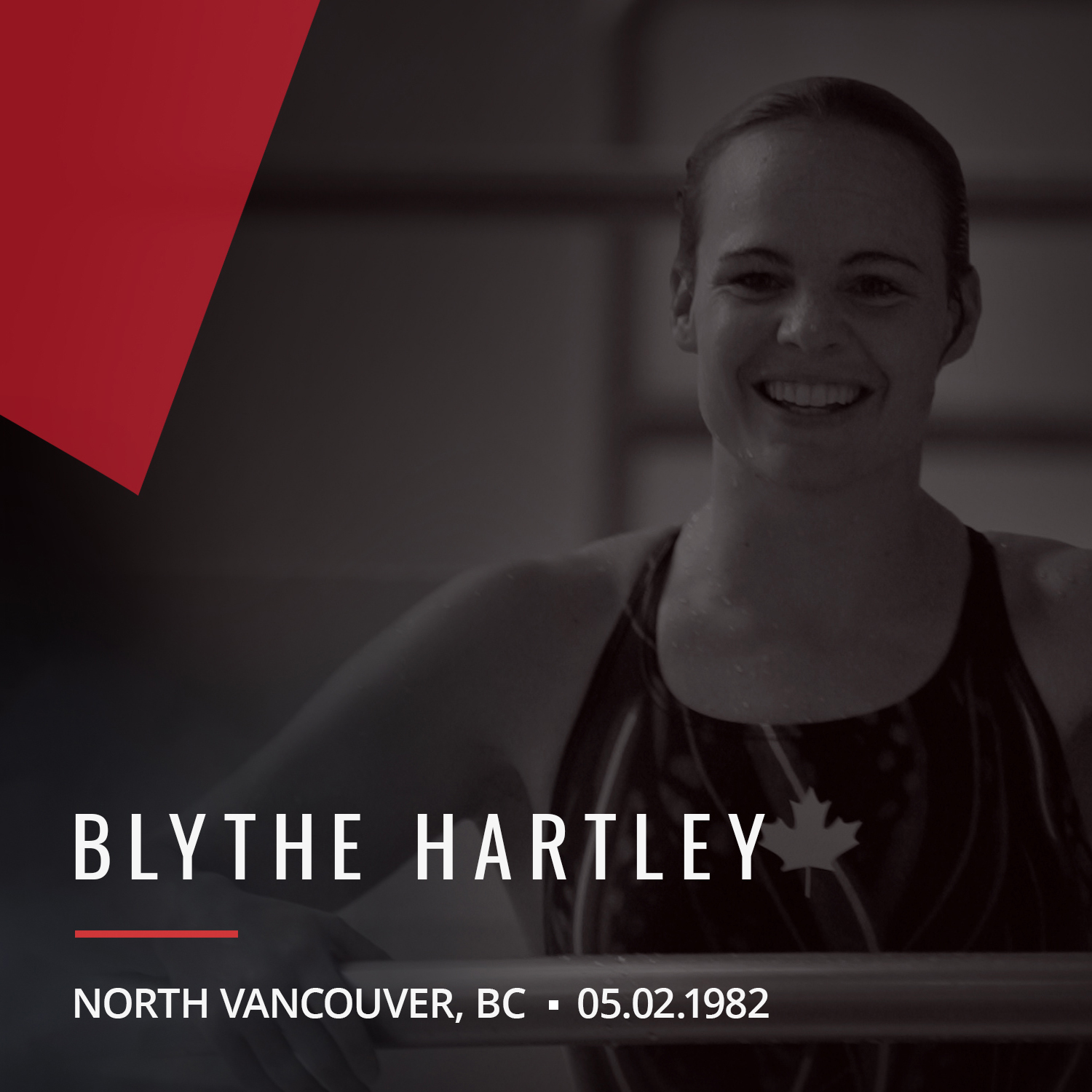
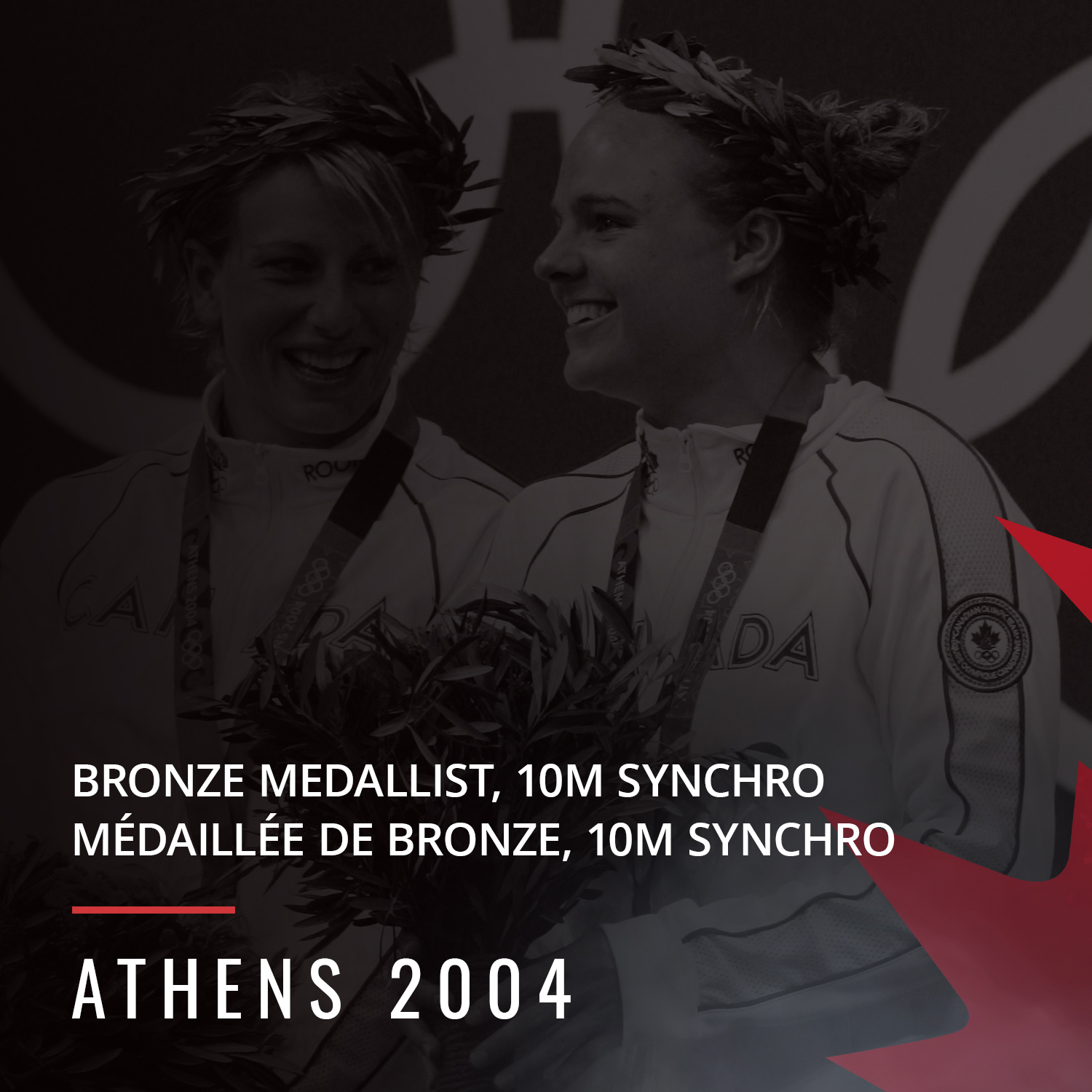
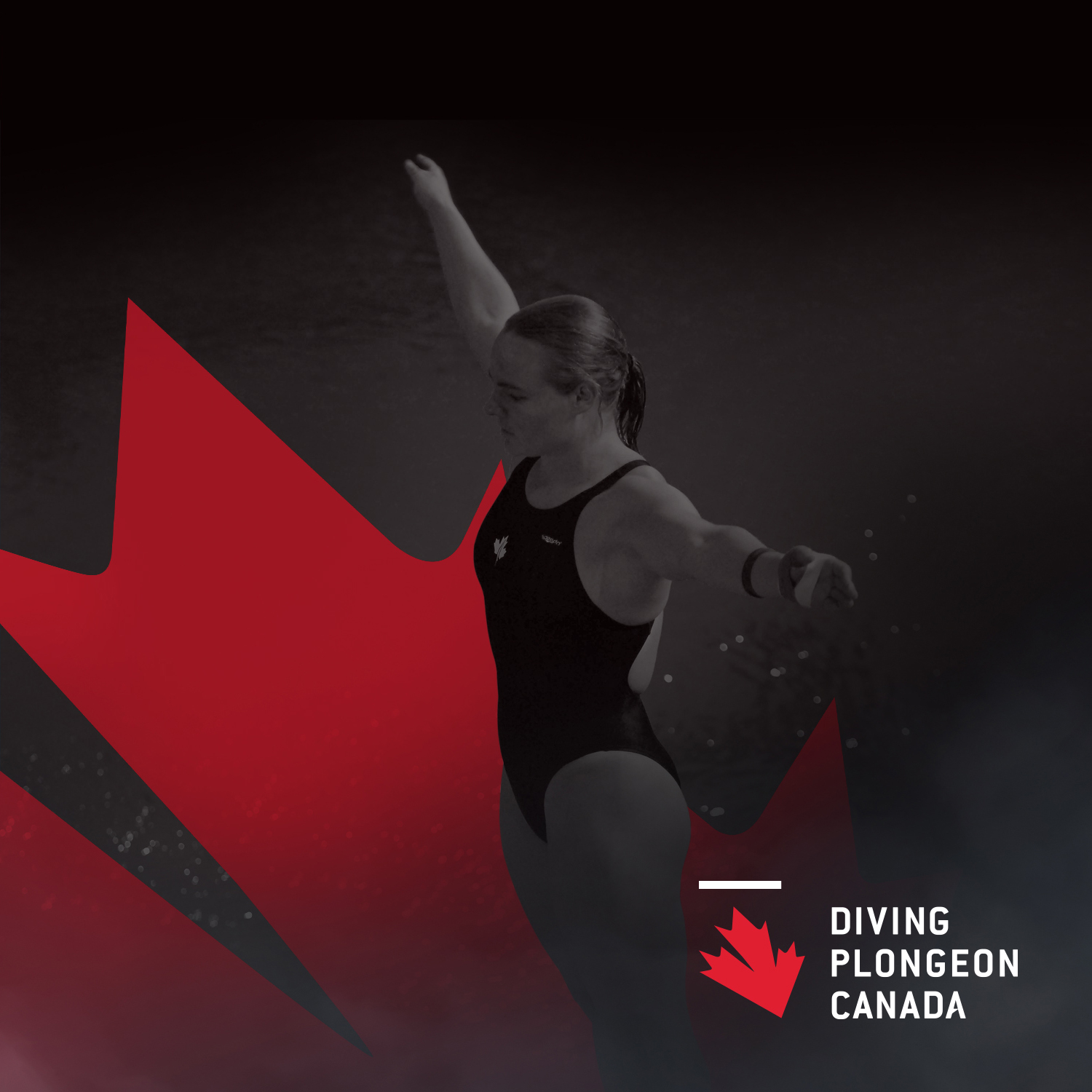
EMILIE HEYMANS
Not only did Émilie compete at four Olympic Games, but she was also the first diver to win medals at four consecutive Olympic Games. On the 10m platform, she won silver with Anne Montminy (2000), bronze with Blythe Hartley (2004); and on 3m springboard, she won bronze with Jennifer Abel (2012). Having won the world championship on the 10m platform in 2003, she had to wait five years to get on the Olympic podium individually, which she did in Beijing in 2008 (silver).
Émilie a participé non seulement à quatre Jeux olympiques, elle a été la première plongeuse à remporter une médaille à quatre Jeux consécutifs. À la plateforme de 10m, elle a remporté l’argent avec sa partenaire Anne Montminy (2000) et le bronze avec Blythe Hartley (2004); au tremplin de 3m, elle a remporté la médaille de bronze avec Jennifer Abel (2012). Championne du monde à la plateforme de 10m en 2003, elle a dû attendre cinq ans pour se hisser sur le podium olympique à l’individuel, en remportant la médaille d’argent à Pékin en 2008.
BIOGRAPHY (EN)
Born: December 14, 1981
Hometown: Saint-Lambert, QC
Olympics: Sydney 2000, Athens 2004, Beijing 2008, London 2012
Highlight: first diver to win medals at four consecutive Olympic Games
Born in Belgium to an Olympic fencer, Émilie started her life with high sporting expectations. A competitive gymnast, she dreamed of reaching the Olympics one day. She switched to diving after her coaches cut her dream short by moving her to a lower level. Initially, she didn’t think she’d like the idea of getting wet, but diving turned out to be more similar to her favourite events of floor and vault than she had expected. Her talent was so evident, she quickly caught the eye of CAMO head coach Michel Larouche. She was put in a special training group that among other gymnasts also included future Olympic medallist Alexandre Despatie.
Not many divers can claim they had success as quickly as Émilie. In her first year of diving, she managed to place second on 3m at the junior nationals. Suddenly, the dream of competing at the Olympics was a renewed and attainable goal. That became even more concrete to her as she watched teammate Annie Pelletier win an Olympic medal in the 1996 Olympic Games. Émilie also idealized the beauty and elegance of the Russian divers. This ballet influenced style of diving expressed itself in her own diving as she demonstrated impeccable positions, movements and unforgettable entry lines. Her style and execution led her to one of the most prolific careers in diving.
Not only did Émilie compete at four Olympic Games, she was the first diver to win medals at four consecutive Olympic Games. She won Olympic medals with three different synchro partners in two different events. On the 10m platform, Émilie won silver with Anne Montminy (2000), bronze with Blythe Hartley (2004); and on 3m springboard, she won bronze with Jennifer Abel (2012). Having won the world championship on the 10m platform in 2003, she had to wait five years to get on the Olympic podium individually, which she did in Beijing in 2008 (silver).
Émilie was inducted into the Canadian Olympic Hall of Fame in 2019.
BIOGRAPHIE (FR)
Date de naissance: 14 décembre 1981
Ville natale: Saint-Lambert, QC
Olympiques: Sydney 2000, Athènes 2004, Pékin 2008, Londres 2012
Fait saillant: première plongeuse à remporter une médaille à quatre Jeux consécutifs
Née en Belgique d’une mère escrimeuse olympique, Émilie avait des attentes élevées au début de sa carrière sportive. Jeune gymnaste, elle rêvait d’aller un jour aux Olympiques. Elle est passée au plongeon lorsque ses entraîneurs ont coupé de court son rêve en la reléguant d’un niveau. À ses débuts en plongeon, elle était un peu sceptique de se mouiller, mais à son grand plaisir, le plongeon se rapprochait beaucoup de l’exercice au sol et du saut de cheval, ses agrès de gymnastique préférés. Son talent était si évident qu’elle a rapidement attiré l’attention de Michel Larouche, l’entraîneur-en-chef du club CAMO. On l’a placée dans un groupe d’entraînement spécial qui incluait d’autres gymnastes, dont le futur médaillé olympique, Alexandre Despatie.
Peu de plongeurs peuvent se vanter d’avoir obtenu du succès aussi rapidement qu’Émilie. À sa première année de plongeon, elle s’est classée deuxième au 3m aux championnats nationaux junior. Soudainement, ce rêve olympique a été renouvelé et semblait à sa portée. Ce rêve s’est davantage concrétisé lorsqu’elle a vu sa coéquipière Annie Pelletier remporter le bronze aux Jeux Olympiques de 1996. Émilie était passionnée par la beauté et l’élégance des plongeurs russes. Ce style de plongeon inspiré par le ballet s’exprimait dans son propre plongeon alors qu’elle réalisait des positions et des mouvements impeccables, en plus d’entrées à l’eau inoubliables. Ce style et son exécution lui ont permis d’avoir l’une des carrières les plus prolifiques du plongeon.
Émilie a participé non seulement à quatre Jeux olympiques, elle a été la première plongeuse à remporter une médaille à quatre Jeux consécutifs. Émilie a remporté des médailles olympiques avec trois partenaires de synchro différentes dans deux épreuves différentes. À la plateforme de 10m, Émilie a remporté l’argent avec sa partenaire Anne Montminy (2000) et le bronze avec Blythe Hartley (2004); au tremplin de 3m, elle a remporté la médaille de bronze avec Jennifer Abel (2012). Championne du monde à la plateforme de 10m en 2003, elle a dû attendre cinq ans pour se hisser sur le podium olympique à l’individuel, en remportant la médaille d’argent à Pékin en 2008.
Émilie a été intronisée au Temple de la renommée olympique du Canada en 2019.
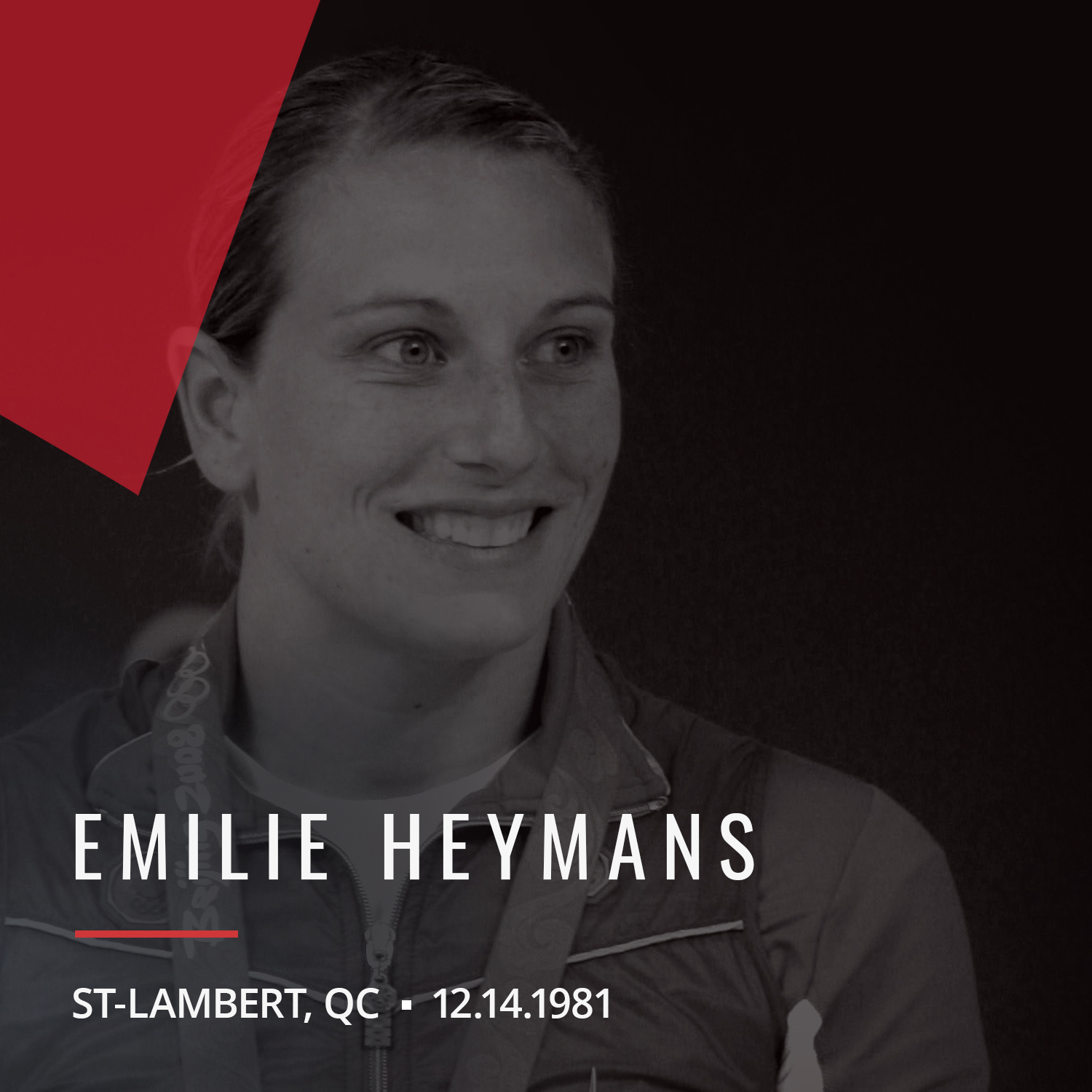
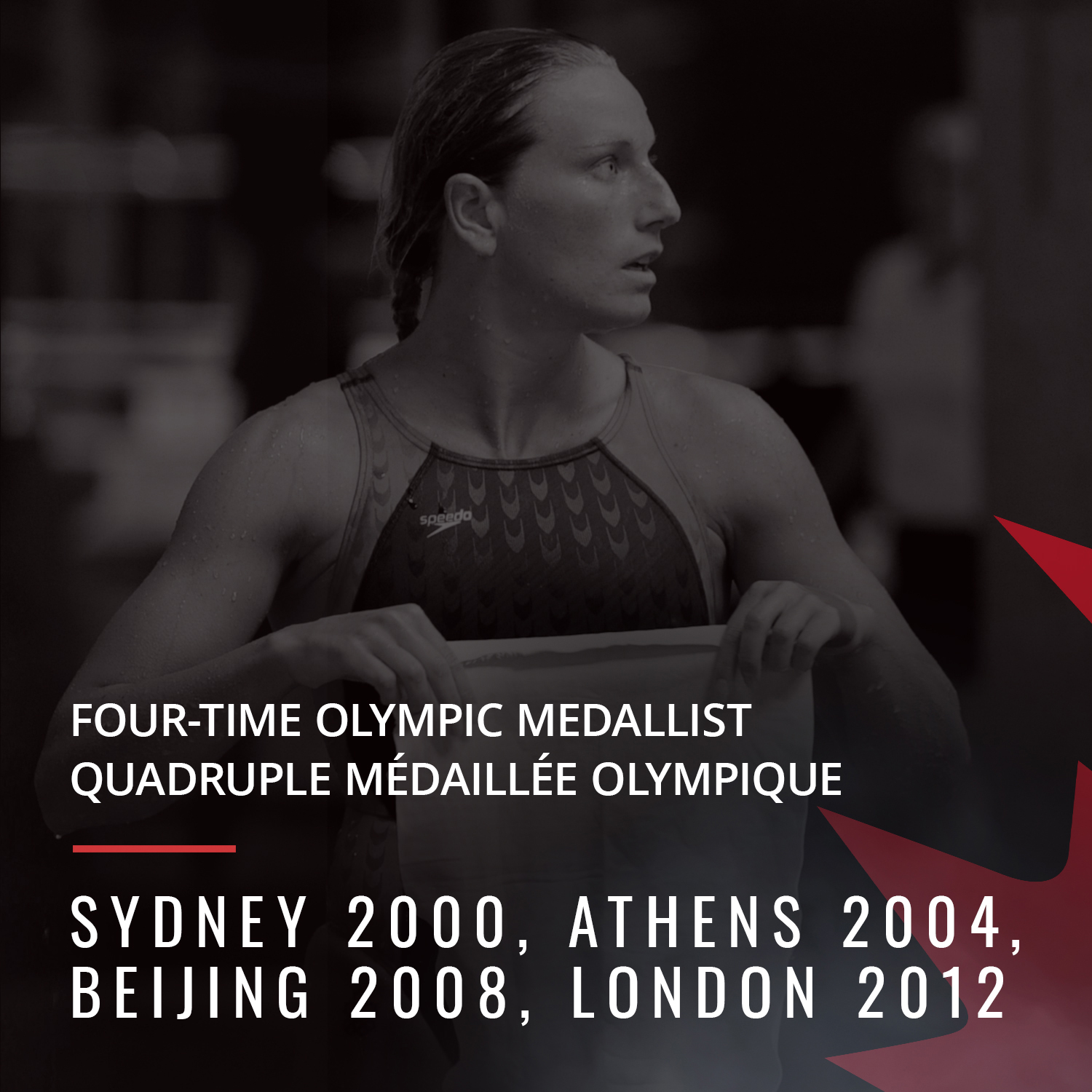
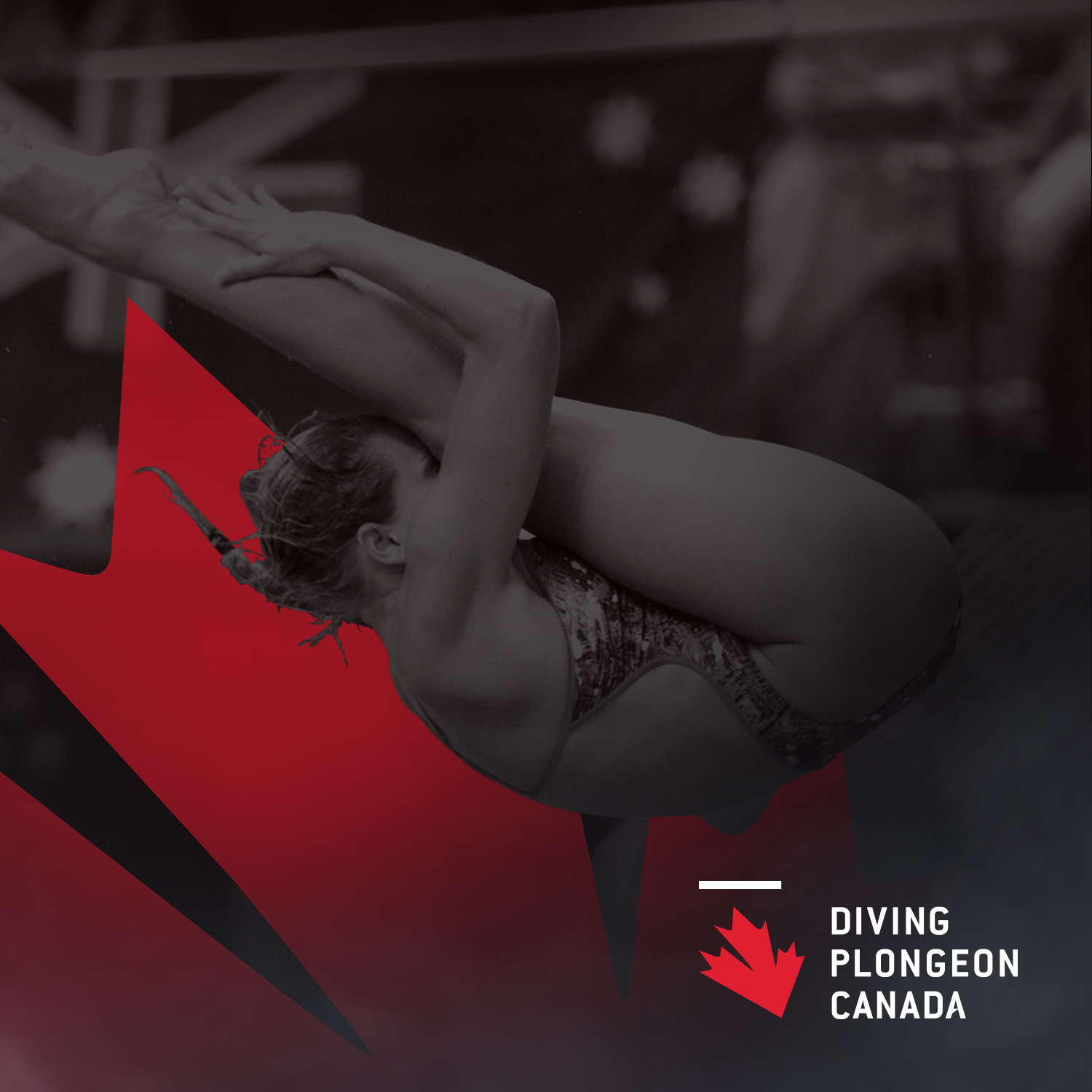
ALEXANDRE DESPATIE
A three-time world champion, Alexandre competed at four consecutive Olympic Games: Sydney (2000), Athens (2004), Beijing (2008) and London (2012). After narrowly missing the podium in 2000, he won silver medals on 3m in both 2008 and 2012. He also made history by becoming the only diver ever to have won a world championship on all three boards (1m, 3m, and tower).
Triple champion du monde, Alexandre a participé à quatre Jeux olympiques consécutifs: Sydney (2000), Athènes (2004), Pékin (2008) et Londres (2012). Après avoir manqué de peu le podium en 2000, il a remporté des médailles d’argent au 3m en 2008 et 2012. Il a également marqué l’histoire en devenant le seul plongeur à être couronné champion du monde dans les trois disciplines (1 m, 3 m et tour).
BIOGRAPHY (EN)
Born: June 8, 1985
Hometown: Laval, QC
Olympics: Sydney 2000, Athens 2004, Beijing 2008, London 2012
Highlight: silver (3m) in 2004 and 2008
Alexandre Despatie burst into Canadian and international consciousness when he won the 1998 Commonwealth Games at just 13 years of age, and over the next 14 years, he would provide Canadians and diving fans around the world with many other equally incredible performances.
Alex first started diving in his backyard pool with his sister before he could even swim. He loved to “play the Olympics” and then would get fished out of the water over and over again. His father knew Olympic gold medallist Sylvie Bernier’s husband and this connection brought Alex to the CAMO diving club as soon as he was old enough to train.
When Alex saw Breaking the Surface: The Greg Louganis Story, he became obsessed with the phenomenal American diver. He even started signing his homework assignments as “Alex Louganis.” The Russian superstar, Dmitri Sautin, would also propel Alex. First as an idol, then with his longevity, as a fellow competitor.
A generational talent, Alex became competitive with the best divers in Canada at only 12 years of age, and then qualified for and won the Commonwealth Games in 1998. After this, he set his sights on the Olympics and two years later, he narrowly missed a medal, placing 4th on platform at the 2000 Olympics in Sydney, Australia. This launched an Olympic career that would see him participate in four consecutive Games, winning silver medals on 3m in both 2008 and 2012.
At the world championships level, Alex is unequalled in the history of this sport. He is the only diver ever to have won a world championship on all three boards (1m, 3m, and tower).
His list of international podiums is impressively long and includes 7 medals at the Pan American Games, 11 at the Commonwealth Games, 9 at the world championships, and 2 at the Olympic Games.
Alex was inducted in to Canada’s Sports Hall of Fame in 2018 and the Canadian Olympic Hall of Fame in 2019.
BIOGRAPHIE (FR)
Date de naissance: 8 juin 1985
Ville natale: Laval, QC
Olympiques: Sydney 2000, Athènes 2004, Pékin 2008, Londres 2012
Fait saillant: argent (3m) en 2004 et 2008
Alexandre Despatie a fait une entrée fracassante dans la conscience du public canadien et international lorsqu’il a remporté l’or aux Jeux du Commonwealth de 1998 alors qu’il n’était âgé que de 13 ans. Au cours des 14 prochaines années, il offrirait plusieurs autres performances tout aussi incroyables à ses partisans canadiens et du monde entier.
Alex a commencé à plonger avec sa sœur dans leur piscine avant même d’avoir appris à nager. Il adorait « jouer aux Olympiques » et on devait le repêcher de l’eau, encore et encore. Son père connaissait le mari de Sylvie Bernier, médaillée d’or olympique en plongeon, et c’est cette connaissance qui a amené Alex au club de plongeon CAMO, dès qu’il avait atteint l’âge pour s’entraîner.
Lorsqu’Alex a vu Breaking the Surface: The Greg Louganis Story, il est devenu complètement obsédé du phénoménal plongeur américain. Il signait même ses devoirs : « Alex Louganis ». L’étoile Russe, Dmitri Sautin, a également marqué le jeune Alex. Au début comme une idole et par la suite, grâce à sa longévité dans le sport, comme confrère en compétition.
Un talent qui ne survient qu’une fois par génération, Alex rivalisait avec les meilleurs plongeurs du Canada lorsqu’il avait à peine 12 ans. Il s’était qualifié et a remporté les Jeux du Commonwealth en 1998. Ensuite, il a fixé sa mire sur les Olympiques. Deux ans plus tard, il a raté un podium de peu, terminant 4e à la plateforme aux Jeux olympiques de 2000 à Sydney, en Australie. Il s’agissait de sa première de quatre participations consécutives aux Jeux olympiques, où il a remporté deux médailles d’argent au 3m : en 2008 et 2012.
Aux Championnats du monde, les résultats d’Alex sont sans égal dans l’histoire du sport. Il est le seul plongeur de l’histoire à être champion du monde sur les trois tremplins (1m, 3m et plateforme).
Sa liste de podiums internationaux est d’une longueur impressionnante et inclut 7 médailles aux Jeux panaméricains, 11 aux Jeux du Commonwealth, 9 aux championnats du monde et 2 aux Olympiques.
Alex a été intronisé au Panthéon des sports canadiens en 2018 et au Temple de la renommée olympique du Canada en 2019.
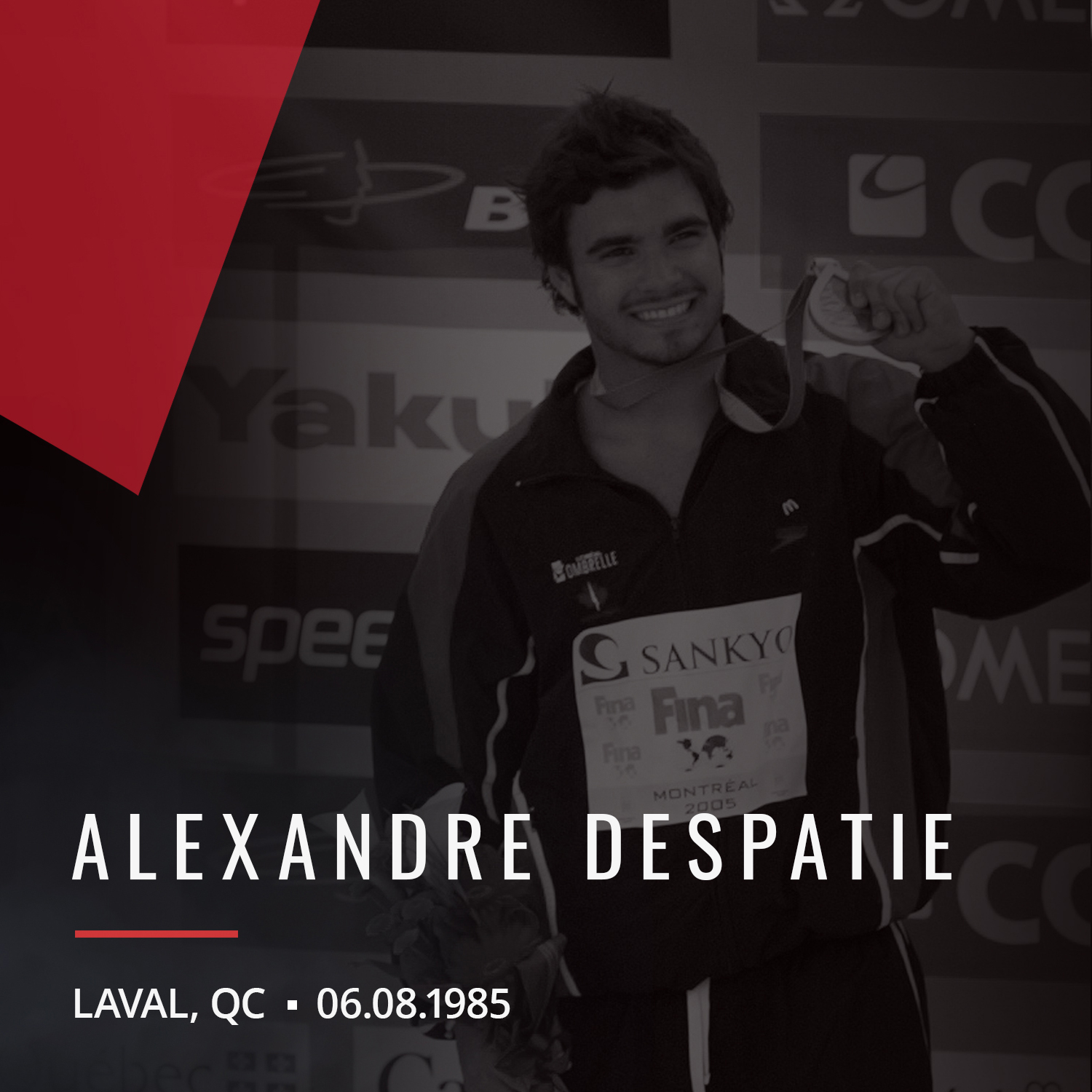
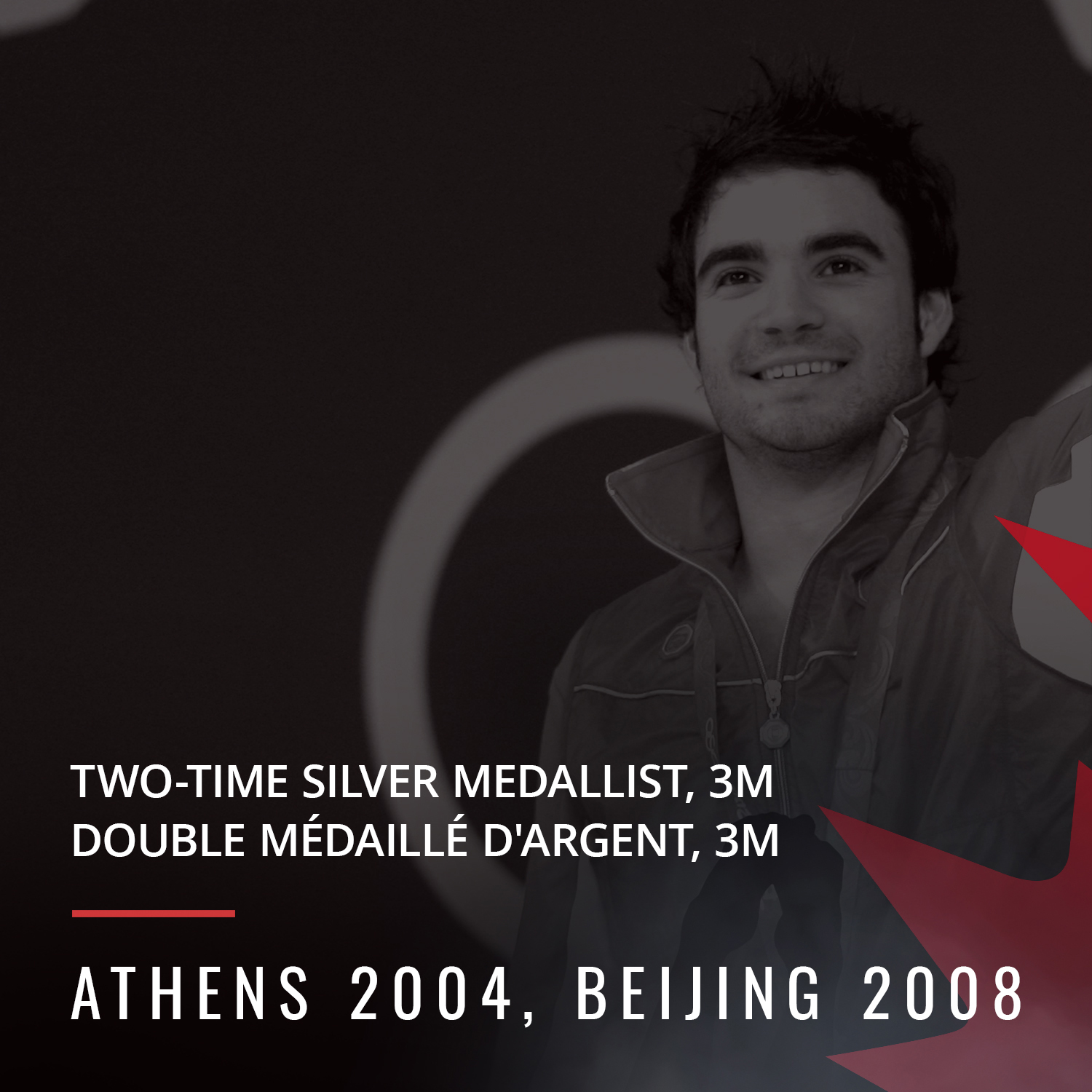
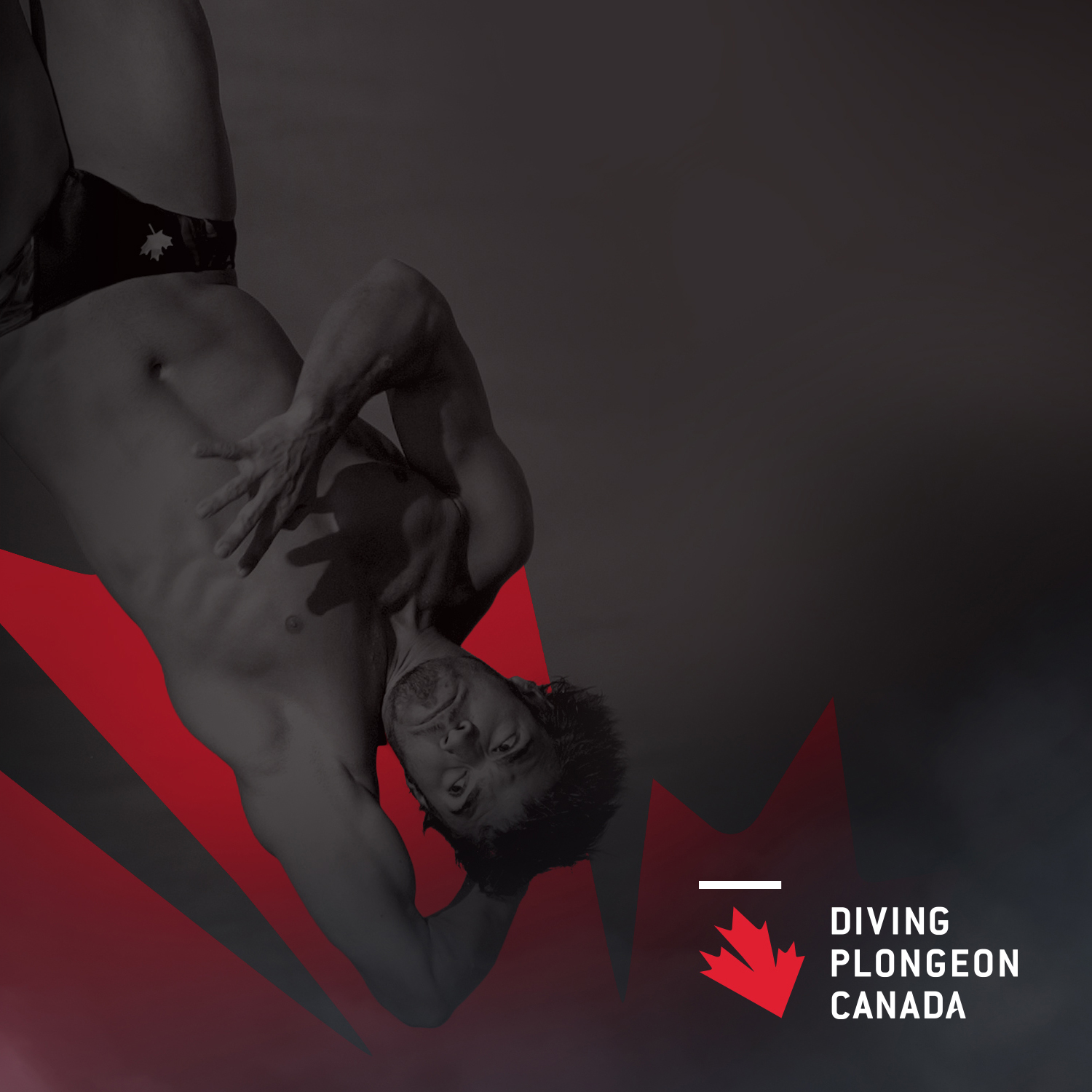
ROSELINE FILION
Having qualified for and competed in three Olympic Games (2008, 2012, and 2016), Roseline won two bronze medals on 10m synchro – one in 2012 and the other in 2016 – both alongside her long-time partner, Meaghan Benfeito. In addition to her success at the Olympics, she also stepped onto the podium at every major international competition that she entered.
S’étant qualifiée et ayant participé à trois Jeux olympiques (2008, 2012 et 2016), Roseline a remporté deux médailles de bronze au 10m synchro (2012 et 2016) aux côtés de Meaghan Benfeito, sa partenaire de longue date. En plus de ses succès olympiques, elle a également accédé au podium à chacun des événements majeurs internationaux auxquels elle a participé.
BIOGRAPHY (EN)
Born: July 3, 1987
Hometown: Laval, QC
Olympics: Beijing 2008, London 2012, Rio 2016
Highlight: bronze (10m synchro) in 2012 and 2016
Inspired by Annie Pelletier’s riveting bronze medal performance at the 1996 Olympics, Roseline made the switch from gymnastics to diving at 5 years of age. She informed her parents she was going to be just like Annie, and that September she started diving.
Less than 10 years after Annie’s inspiring performance, Roseline was on the world stage herself in Montreal at the 2005 FINA World Aquatic Championships. She partnered with Meaghan Benfeito to win a bronze medal in the 10m synchro event in front of her family and friends. This was the beginning of what turned out to be a historic partnership.
Roseline’s daily training environment was a who’s who of Canadian diving stars, including Alexandre Despatie and Émilie Heymans. Daily inspiration, work ethic and dedication poured into Roseline from her teammates, and she quickly modeled her own training ethos on that of the champions surrounding her.
Initially somewhat of an underdog, Roseline exemplified what hard work and focus can bring you. She consistently exceeded expectations, with impressive performances at every level.
Becoming one of Canada’s dependable elite performers, Roseline notched many international medals in both individual and synchronized events.
Having qualified for and competed in three Olympic Games (2008, 2012, and 2016), Roseline won two bronze medals on 10m synchro – one in 2012 and the other in 2016 – both alongside her long-time partner, Meaghan Benfeito.
In addition to her success at the Olympics, she also stepped onto the podium at the Commonwealth Games, Pan American Games, FINA World Championships, FINA World Cup, FINA Diving World Series, and the FINA Diving Grand Prix.
BIOGRAPHIE (FR)
Date de naissance: 3 juillet 1987
Ville natale: Laval, QC
Olympiques: Pékin 2008, Londres 2012 et Rio 2016
Fait saillant: bronze (10m synchro) en 2012 et 2016
Inspirée par la performance remarquable d’Annie Pelletier couronnée d’une médaille de bronze aux Olympiques de 1996, Roseline est passée de la gymnastique au plongeon à l’âge de 5 ans. Elle a déclaré à ses parents qu’elle allait faire comme Annie et en septembre de cette année-là, s’est lancée dans le plongeon.
Moins de 10 ans après la performance inspirante d’Annie, Roseline s’est retrouvée elle-même sur la scène internationale aux Championnats du monde aquatiques 2005 de la FINA à Montréal. En duo avec sa partenaire Meaghan Benfeito, elles ont remporté la médaille de bronze au 10m synchro devant leurs familles et amis. Ce fut le début d’un partenariat qui s’est avéré historique.
L’environnement quotidien d’entraînement de Roseline débordait d’étoiles du plongeon canadien, dont Alexandre Despatie et Émilie Heymans. Roseline en retirait une inspiration au quotidien, motivée par leur éthique du travail et leur dévouement constant à la tâche. Elle a rapidement adopté une philosophie d’entraînement qui modelait celle des champions qui l’entouraient.
Au départ, Rosie n’était pas considérée parmi les favorites mais ses résultats ont été le résultat d’un travail acharné et d’un dévouement inlassable. Elle excédait constamment les attentes en réussissant d’impressionnantes performances à chaque niveau.
Roseline s’est établie comme l’une des athlètes d’élites les plus fiables du Canada, remportant plusieurs médailles internationales tant aux épreuves individuelles qu’en synchro.
S’étant qualifiée et ayant participé à trois Jeux olympiques (2008, 2012 et 2016), Roseline a remporté deux médailles de bronze au 10m synchro (2012 et 2016) aux côtés de Meaghan Benfeito, sa partenaire de longue date.
En plus de ses succès olympiques, elle a également accédé aux podiums des Jeux du Commonwealth, Jeux panaméricains, Championnats du monde de la FINA, Coupe du monde de la FINA, Séries mondiales de plongeon de la FINA et Grand Prix de la FINA.
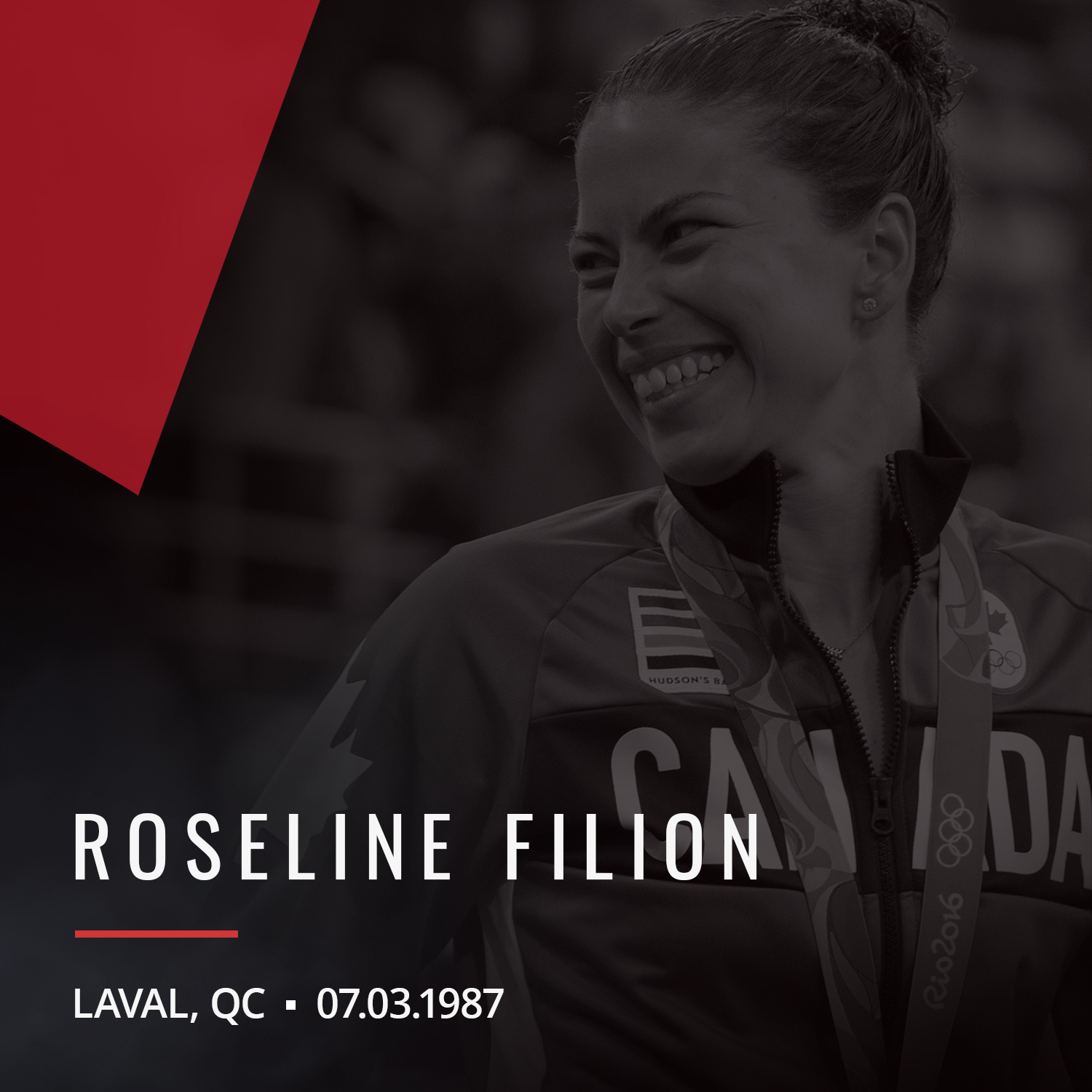
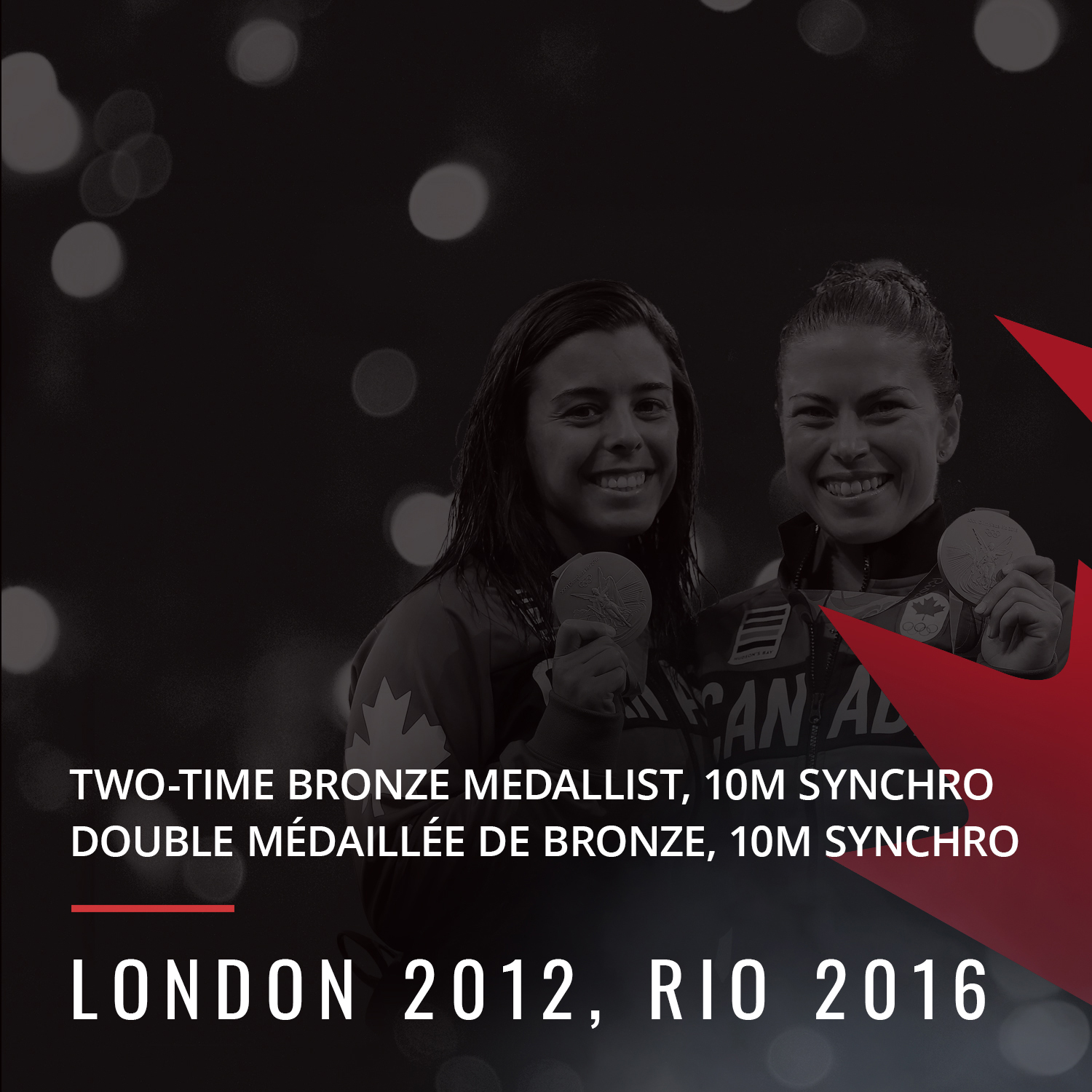
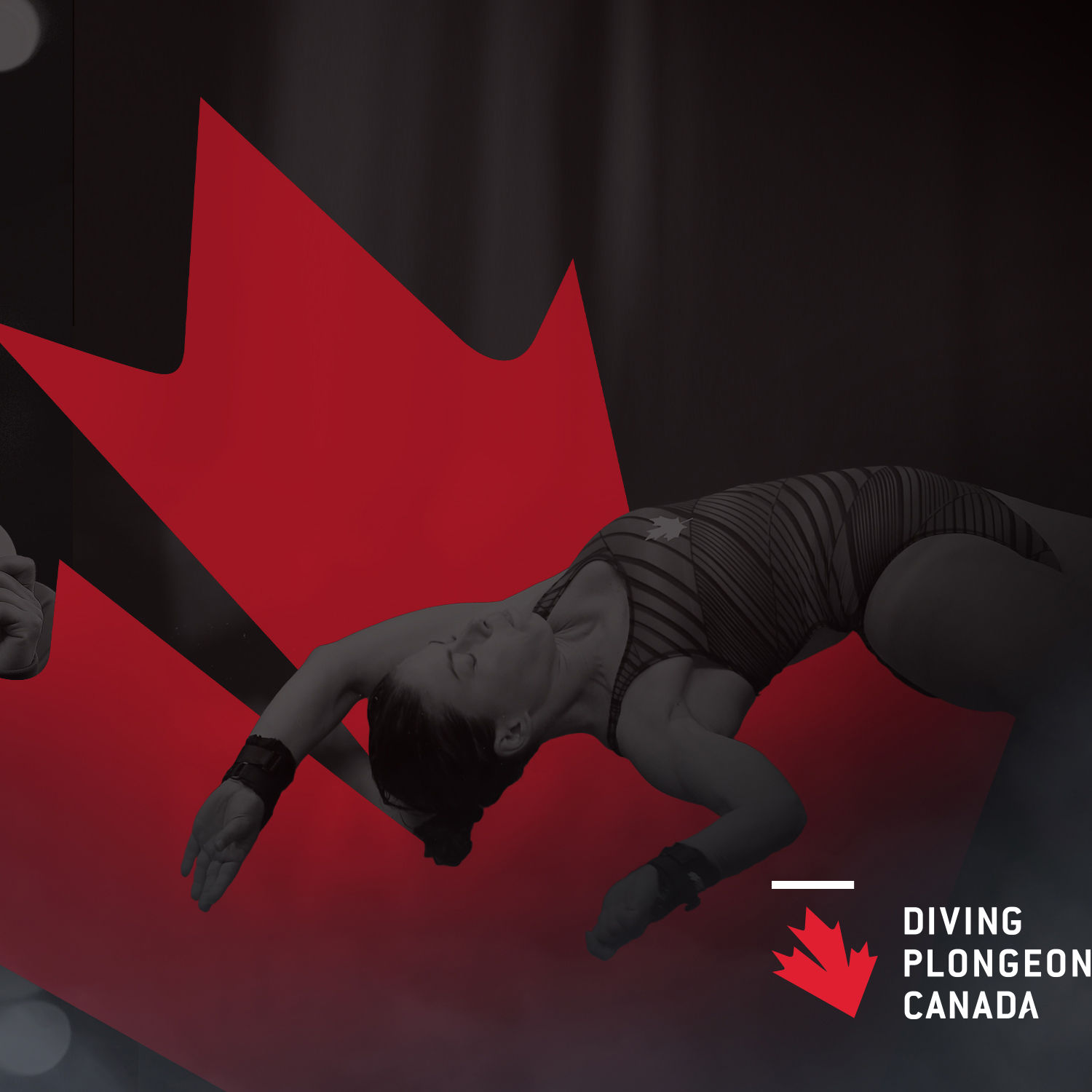
© Diving Canada 2020 / All rights reserved